Étiquette : Ghiberti
LOUVRE AUDIO GUIDE: Leonardo and Verrochio’s workshop
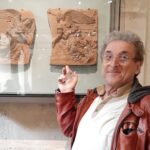
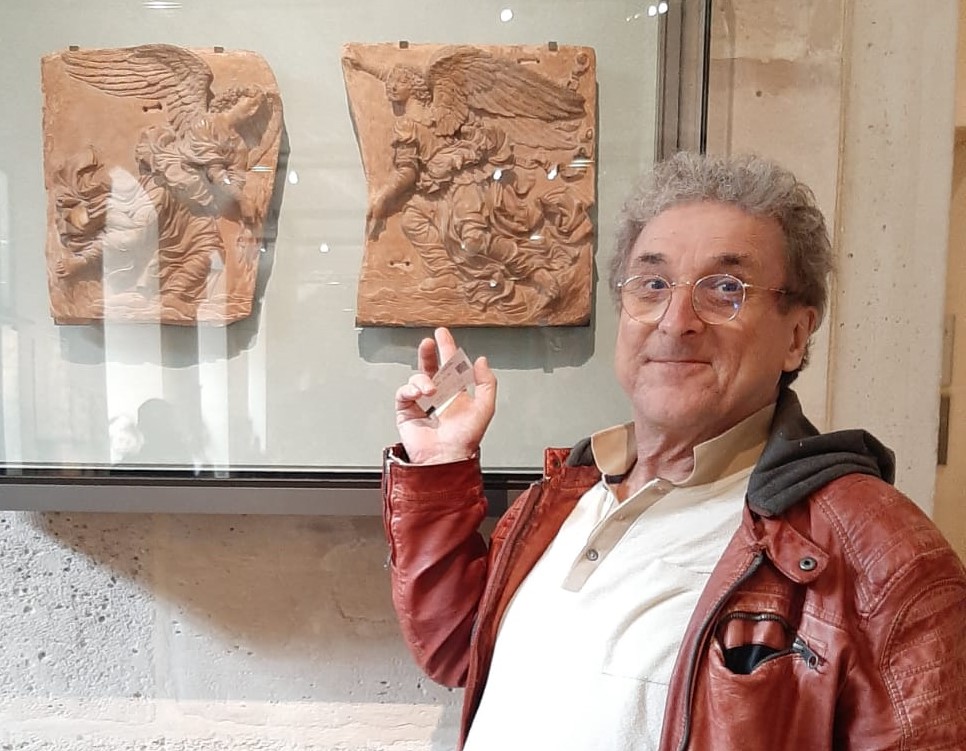
Listen:
to the audio on this website
Read:
Van Eyck, a Flemish Painter using Arab Optics?
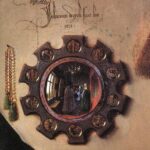

What follows is an edited transcript of a lecture by Karel Vereycken on the subject of “Perspective in XVth-century Flemish religious painting”.
It was delivered at the international colloquium “La recherche du divin à travers l’espace géométrique” (The quest for the divine through geometrical space) at the Paris Sorbonne University on April 26-28, 2006, under the direction of Luc Bergmans, Department of Dutch Studies (Paris IV Sorbonne University).
Introduction
« Perspective in XVth-century Flemish religious painting ». At first glance, this title may seem surprising. While the genius of fifteenth-century Flemish painters is universally attributed to their mastery of drying oil and their intricate sense of detail, their spatial geometry as such is usually identified as the very counter-example of the “right perspective”.
Disdained by Michelangelo and his faithful friend Vasari, the Flemish « primitives » would never have overcome the medieval, archaic and empirical model. For the classical “narritive”, still in force today, stipulates that only « Renaissance » perspective, obeying the canon of « linear », “mathematical” perspective, is the only « right », and the “scientific” one.
According to the same narrative, it was the research carried out around 1415-20 by the Duomo architect Filippo Brunelleschi (1377-1446), superficially mentioned by Antonio Tuccio di Manetti some 60 years later, which supposedly enabled Leon Battista Alberti (1404-1472), proclaiming himself Brunelleschi’s intellectual heir, to invent « perspective ».

In 1435, in De Pictura, a book entirely devoid of graphic illustration, Alberti is said to have formulated the premises of a perspectivist canon capable of representing, or at least conforming to, our modern notions of Cartesian space-time (NOTE 1), a space-time characterized as « entirely rational, i.e. infinite, continuous and homogeneous », « in one word, a purely mathematical space [dixit Panofsky] » (NOTE 2)
Long afterwards, in a drawing from the Codex Madrid, Leonardo da Vinci (1452-1519) attempted to unravel the workings of this model.
But in the same manuscript, he rigorously demonstrated the inherent limitations of the Albertian Renaissance perspectivist canon.

The drawing on f°15, v° clearly shows that the simple projection of visual pyramid cross-sections on a plane paradoxically causes their size to increase the further they are from the point of vision, whereas reality would require exactly the opposite. (NOTE 3)
With this in mind, Leonardo began to question the mobility of the eye and the curvilinear nature of the retina. Refusing to immobilize the viewer on an exclusive point of vision (NOTE 4), Leonardo used curvilinear constructions to correct these lateral deformations. (NOTE 5) In France, Jean Fouquet and others worked along the same lines.
But Leonardo’s powerful arguments were ignored, and he was unable to prevent this rewriting of history.
Despite this official version of art history, it should be noted that at the time, Flemish painters were elevated to pinnacles by Italy’s greatest patrons and art connoisseurs, specifically for their ability to represent space.
Bartolomeo Fazio, around the middle of the 15th century, observed that the paintings of Jan van Eyck, an artist billed as the « principal painter of our time », showed « tiny figures of men, mountains, groves, villages and castles rendered with such skill that one would think them fifty thousand paces apart. » (NOTE 6)
Such was their reputation that some of the great names in Italian painting had no qualms about reproducing Flemish works identically. I’m thinking, for example, of the copy of Hans Memlinc‘s Christ Crowned with Thorns at the Genoa Museum, copied by Domenico Ghirlandajo (Philadelphia Museum).
But post-Michelangelo classicism deemed the non-conformity of Flemish spatial geometry with Descartes’ « extended substance » to be an unforgivable crime, and any deviation from, or insubordination to, the « Renaissance » perspectivist canon relegated them to the category of « primitives », i.e. « empiricists », clearly devoid of any scientific culture.
Today, ironically, it is almost exclusively those artists who explicitly renounce all forms of perspectivist construction in favor of pseudo-naïveté, who earn the label of modernity…
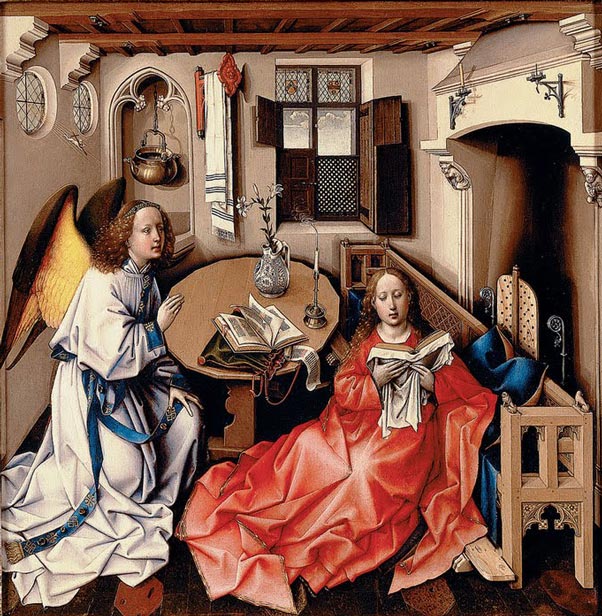
In any case, current prejudices mean that 15th-century Flemish painting is still accused of having ignored perspective.
It’s true, however, that at the end of the XIVth century, certain paintings by Melchior Broederlam (c. 1355-1411) and others by Robert Campin (1375-1444) (Master of Flémalle) show the viewer interiors where plates and cutlery on tables threaten to suddenly slide to the floor.
Nevertheless, it must be admitted that whenever the artist « ignores » or disregards the linear perspective scheme, he seems to do so more by choice than by incapacity. To achieve a limpid composition, the painter prioritizes his didactic mission to the detriment of all other considerations.
For example, in Campin’s Mérode Altarpiece, the exaggerated perspective of the table clearly shows that the vase is behind the candlestick and book.


Jan van Eyck’s Lam Gods (Mystic Lamb) in Ghent is another example.
Never could so many figures, with so much detail and presence, be shown with a linear perspective where the figures in the foreground would hide those behind. (NOTE 7)
But the intention to approximate a credible sense of space and depth remains.
If this perspective seems flawed by its linear geometry, Campin imposes an extraordinary sense of space through his revolutionary treatment of shadows. As every painter knows, light is painted by painting shadow.
In Campin’s work, every object and figure is exposed to several sources of light, generating a darker central shadow as the fruit of crossed shadows.
Van Eyck influenced by Arab Optics?

Roger Bacon, statue in Oxord.
This new treatment of light-space has been largely ignored. However, there are several indications that this new conception was partly the result of the influence of « Arab » science, in particular its work on optics.
Translated into Latin and studied from the XIIth century onwards, their work was developed in particular by a network of Franciscans whose epicenter was in Oxford (Robert Grosseteste, Roger Bacon, etc.) and whose influence spread to Chartres, Paris, Cologne and the rest of Europe.
It should be noted that Jan van Eyck (1395-1441), an emblematic figure of Flemish painting, was ambassador to Paris, Prague, Portugal and England.
I’ll briefly mention three elements that support this hypothesis of the influence of Arab science.
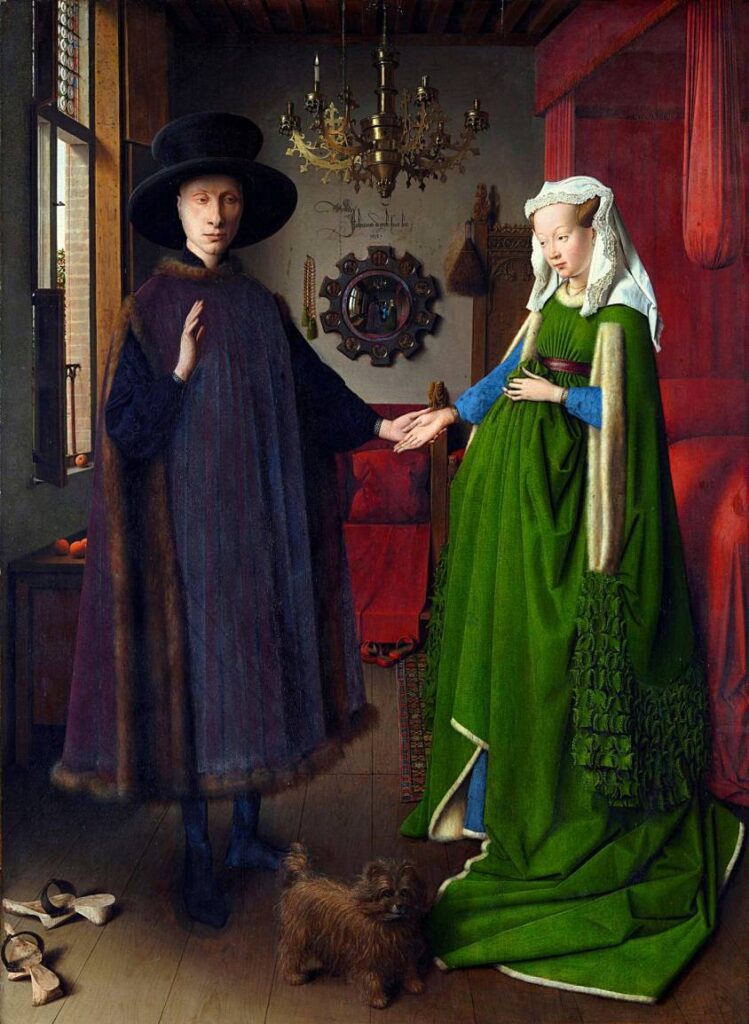
Curved mirrors
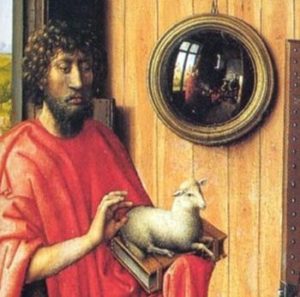
Robert Campin (master of Flémalle) in the Werl Triptych (1438) and Jan van Eyck in the Arnolfini portrait (1434), each feature convex mirrors of considerable size.
It is now certain that glaziers and mirror-makers were full members of the Saint Luc guild, the painters’ guild. (NOTE 8)
But it is relevant to know that Campin, now recognized as having run the workshop in Tournai where the painters Van der Weyden and Jacques Daret were trained, produced paintings for the Franciscans in this city. Heinrich Werl, who commissioned the altarpiece featuring the convex mirror, was an eminent Franciscan theologian who taught at the University of Cologne.

Artistic representation of Ibn Al-Haytam (Alhazen)
These convex and concave (or ardent) mirrors were much studied during the Arab renaissance of the IXth to XIth centuries, in particular by the Arab philosopher Al-Kindi (801-873) in Baghdad at the time of Charlemagne.
Arab scientists were not only in possession of the main body of Hellenic work on optics (Euclid‘s Optics, Ptolemy‘s Optics, the works of Heron of Alexandria, Anthemius of Tralles, etc.), but it was sometimes the rigorous refutation of this heritage that was to give science its wings.
After the decisive work of Ibn Sahl (Xth century), it was that of Ibn Al-Haytam (Latin name : Alhazen) (NOTE 9) on the nature of light, lenses and spherical mirrors that was to have a major influence. (NOTE 10)

As mentioned above, these studies were taken up by the Oxford Franciscans, starting with the English bishop of Lincoln, Robert Grosseteste (1168-1253).
In De Natura Locorum, for example, Grosseteste shows a diagram of the refraction of light in a spherical glass filled with water. And in his De Iride he marvels at this science which he connexts to perspective :
« This part of optics, so well understood, shows us how to make very distant things appear as if they were situated very near, and how we can make small things situated at a distance appear to the size we desire, so that it becomes possible for us to read the smallest letters from incredible distances, or to count sand, or grains, or any small object.«
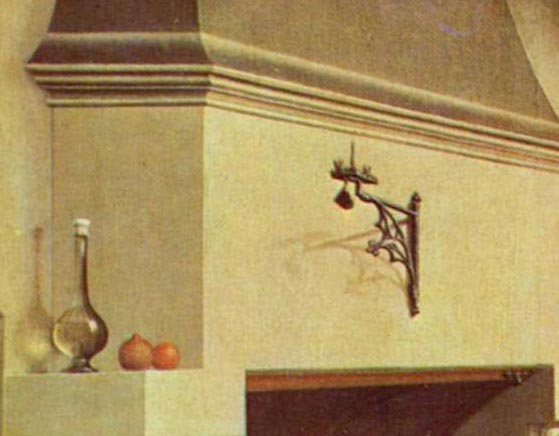
Grosseteste’s pupil Roger Bacon (1212-1292) wrote De Speculis Comburentibus, a specific treatise on « Ardent Mirrors » which elaborates on Ibn Al-Haytam‘s work.
Flemish painters Campin, Van Eyck and Van der Weyden proudly display their knowledge of this new scientific and technological revolution metamorphosed into Christian symbolisms.
Their paintings feature not only curved mirrors but also glass bottles, which they use as a metaphor for the immaculate conception.
A Nativity hymn of that period says:
« As through glass the ray passed without breaking it, so of the Virgin Mother, Virgin she was and virgin she remained… » (NOTE 11)
The Treatment of Light
In his Discourse on Light, Ibn Al-Haytam develops his theory of light propagation in extremely poetic language, setting out requirements that remind us of the « Eyckian revolution ». Indeed, Flemish « realism » and perspective are the result of a new treatment of light and color.
Ibn Al-Haytam:
« The light emitted by a luminous body by itself -substantial light- and the light emitted by an illuminated body -accidental light- propagate on the bodies surrounding them. Opaque bodies can be illuminated and then in turn emit light. »

This physical principle, theorized by Leonardo da Vinci, is omnipresent in Flemish painting. Just look at the images reflected in the helmet of St. George in Van Eyck‘s Madonna to Canon van der Paele (NOTE 12).
In each curved surface of Saint George’s helmet, we can identify the reflection of the Virgin and even a window through which light enters the painting.
The shining shield on St. George’s back reflects the base of the adjacent column, and the painter’s portrait appears as a signature. Only a knowledge of the optics of curved surfaces can explain this rendering.
Ibn Al-Haytam:
« Light can penetrate transparent bodies: water, air, crystal and their counterparts. »
And :
« Transparent bodies have, like opaque bodies, a ‘receiving power’ for light, but transparent bodies also have a ‘transmitting power’ for light.«
Isn’t the development of oil mediums and glazes by the Flemish an echo of this research? Alternating opaque and translucent layers on very smooth panels, the specificity of the oil medium alters the angle of light refraction.
In 1559, the painter-poet Lucas d’Heere referred to van Eyck‘s paintings as « mirrors, not painted scenes.«
Binocular perspective



Before the advent of « right » central linear perspective, art historians sought a coherent explanation for its birth in the presence of several seemingly disparate vanishing points by theorizing a so-called central « fishbone » perspective.
In this model, a number of vanishing lines, instead of coinciding in a single central vanishing point on the horizon, either end up in a « vanishing region » (NOTE 13), or align with what some call a vertical « vanishing axis », forming a kind of « fishbone ».
French Professor Dominique Raynaud, who worked for years on this issue, underscores that « all medieval treatises on perspective address the question of binocular vision », notably the Polish scholar Witelo (1230-1280) (NOTE 15) in his Perspectiva (I,27), an insight he also got from the works of Ibn Al-Haytam.
Witelo presents a figure to defend the idea that
« the two forms, which penetrate two homologous points of the surface of the two eyes, arrive at the same point of the concavity of the common nerve, and are superimposed at this point to become one » (Perspectiva, III, 37).
A similar line of reasoning can be found in Roger Bacon‘s Perspectiva Communis, written by John Pecham, Archbishop of Canterbury (1240-1290) for whom:
« the duality of the eyes must be reduced to unity »
So, as Professor Raynaud proposed, if we extend the famous vanishing lines (i.e., in our case, the « fish bones ») until they intersect, the « vanishing axis » problem disappears, as the vanishing lines meet. Interestingly, the result is a perspective with two vanishing points in the central region!

Suddenly, the diagrams drawn up to demonstrate the « empiricism » of the Flemish painters, if viewed from this point of view, reveal a legitimate construction probably based on optics as transmitted by Arab science and rediscovered by Franciscan networks and others.
Two paintings by Jan van Eyck clearly demonstrate that he followed this approach: The Madonna with Canon van der Paele of 1436 and the Dresden Tryptic of 1437.
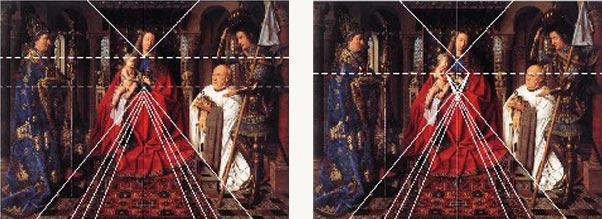

What seemed a clumsy, empirical approach in the form of a « fishbone » perspective (left) turns out to be a binocular perspective construction.
Was this type of perspective specifically Flemish?
A close examination of works by Ghiberti, Donatello and Paolo Uccello, generally dating from the first half of the XVth Century, reveals a mastery of the same principle.


Cusanus
But this whole demonstration is merely a look into the past through the eyes of modern scientific rationality. It would be a grave error not to take into account the immense influence of the Rhenish (Master Eckhart, Johannes Tauler, Heinrich Suso) and Flemish (Hadewijch of Antwerp, Jan van Ruusbroec, etc.) « mystics ».
This trend began to flourish again with the rediscovery of the Christianized neo-Platonism of Dionysius the Areopagite (Vth-VIth century), made accessible… by the new translations of the Franciscan Grosseteste in Oxford.
The spiritual vision of the Aeropagite, expressed in a powerful imagery language, is directly reminiscent of the metaphorical approach of the Flemish painters, for whom a certain type of light is simply the revelation of divine grace.
In On the Heavenly Hierarchy, Dionysius immediately presents light as a manifestation of divine goodness. It ennobles us and enables us to enlighten others:
« Let those who are illuminated be filled with divine clarity, and the eyes of their understanding trained to the work of chaste contemplation; finally, let those who are perfected, once their primitive imperfection has been abolished, share in the sanctifying science of the marvelous teachings that have already been manifested to them; similarly, let the purifier excel in the purity he communicates to others; let the illuminator, gifted with a greater penetration of spirit, equally fit to receive and transmit light, happily flooded with sacred splendor, pour it out in pressing streams on those who are worthy… » [Chap. III, 3]
Let’s think again of the St. George in Van Eyck‘s Madonna to Canon van der Paele, which indeed pours forth the multiple images of the Virgin who enlightens him.
This theo-philosophical trend reached full maturity in the work of Cardinal Nicolas of Cusa (Cusanus) (1401-1464) (NOTE 16), embodying the extremely fruitful encounter of this « negative theology » with Greek science, Socratic knowledge and Christian Humanism.

In contrast to both a science « without a hypothesis of God » and a metaphysics with an esoteric drift, an agapic love leads it to the education of the greatest number, to the defense of the weak and the humiliated.
The Brothers and Sisters of the Common Life, educating Erasmus of Rotterdam and inspiring Cusanus, are the best example of this.
But let’s sketch out some of Cusanus’ key ideas on painting.
In De Icona (The Vision of God) (1453), which he sent to the Benedictine monks of the Tegernsee, Cusanus condenses his fundamental work On Learned Ignorance (1440), in which he develops the concept of the coincidence of opposites. His starting point was a self-portrait of his friend « Roger », the Flemish painter Rogier van der Weyden, which he sent together with his sermon to the monks.
This self-portrait, like the multiple faces of Christ painted in the XVth century, uses an « optical illusion » to create the effect of a gaze that fixes the viewer, regardless of his or her position in front of the altarpiece.
In De Icona, written as a sermon, Cusanus asks monks to stand in a semicircle around the painting and watch this gaze pursue them as they move along the segment of the curve. In fact, he elaborates a pedagogical paradox based on the fact that the Greek name for God, Theos, has its etymological origin in the verb theastai (to see, to look at).
As you can see, he says, God looks at you personally, and his gaze follows you everywhere. He is therefore one and many. And even when you turn away from him, his gaze falls on you. So, miraculously, although he looks at everyone at the same time, he nevertheless establishes a personal relationship with each one. If « seeing » for God is « loving », God’s point of vision is infinite, omniscient and omnipotent love.

A parallel can be drawn here with the spherical mirror at the center of Jan van Eyck’s painting The Arnolfini portrait, painted in 1434, nineteen years before this sermon.
Firstly, this circular mirror is surrounded by the ten stations of Christ’s Passion, juxtaposed by a rosary, an explicit reference to God.
Secondly, it reveals a view of the entire room, an image that completely escapes the linear perspective of the foreground. A view comparable to the allcompassing « Vision of God » developed by Cusanus.
Finally, we see two figures in the mirror, but not the image of the painter behind his easel. These are undoubtedly the two witnesses to the wedding. Instead of signing his painting with « Van Eyck invent. », the painter signed his painting above the mirror with « Van Eyck was here » (NOTE 17), identifying himself as a witness.
As Dionysius the Aeropagite asserted:
« [the celestial hierarchy] transforms its adepts into so many images of God: pure and splendid mirrors where the eternal and ineffable light can shine, and which, according to the desired order, reflect liberally on inferior things this borrowed brightness with which they shine. » [Chap. III, 2]
The Flemish mystic Jan van Ruusbroec (1293-1381) evokes a very similar image in his Spiegel der eeuwigher salicheit (Mirror of eternal salvation) when he says:
« Ende Hi heeft ieghewelcs mensche ziele gescapen alse eenen levenden spieghel, daer Hi dat Beelde sijnre natueren in gedruct heeft. » (And he created each human soul as a living mirror, in which he imprinted the image of his nature).
And so, like a polished mirror, Van Eyck’s soul, illuminated and living in God’s truth, acts as an illuminating witness to this union. (NOTE 18)
So, although the Flemish painters of the XVth century clearly had a solid scientific foundation, they choose such or such perspective depending on the idea they wanted to convey.
In essence, their paintings remain objects of theo-philosophical speculation or as you like « intellectual prayer », capable of praising the goodness, beauty and magnificence of a Creator who created them in His own image. By the very nature of their approach, their interest lay above all in the geometry of a kind of « paradoxical space-light » capable, through enigma, of opening us up to a participatory transcendence, rather than simply seeking to « represent » a dead space existing outside metaphysical reality.
The only geometry worthy of interest was that which showed itself capable of articulating this non-linearity, a « divine » or « mystical » perspective capable of linking the infinite beauty of our commensurable microcosm with the immeasurable goodness of the macrocosm.
Thank you,
NOTES:
- Recently, Italian scholars have pointed to the role of Biagio Pelacani Da Parma (d. 1416), a professor at the University of Padua near Venice, in imposing such a perspective, which privileged only the « geometrical laws of the act of vision and the rules of mathematical calculation ».
- Erwin Panofsky, Perspective as Symbolic Form, p.41-42, Les Éditions de Minuit, Paris, 1975.
- Institut de France, Manuscrit E, 16 v° « the eye [h] perceives on the plane wall the images of distant objects greater than that of the nearer object. »
- Leonardo understands that Albertian perspective, like anamorphosis, condemns the viewer to a single, immobile point of vision.
- See, for example, the slight enlargement of the apostles at the ends of Leonardo da Vinci’s Last Supper in the Milan refectory.
- Baxandall, Bartholomaeus Facius on painting, Journal of the Warburg and Courtauld Institutes, 27, (1964). Fazio is also enthusiastic about a world map (now lost) by Jan van Eyck, in which all the places and regions of the earth are depicted recognizably and at measurable distances.
- To escape this fate, Pieter Bruegel the Elder used a cavalier perspective, placing his horizon line high up.
- Lionel Simonot, Etude expérimentale et modélisation de la diffusion de la lumière dans une couche de peinture colorée et translucide. Application à l’effet visuel des glacis et des vernis, p.9 (PhD thesis, Nov. 2002).
- Ibn Al-Haytam (Alhazen) (965-1039) wrote some 200 works on mathematics, astronomy, physics, medicine and philosophy. Born in Basra, after working on the development of the Nile in Egypt, he travelled to Spain. He is said to have carried out a series of highly detailed experiments on theoretical and experimental optics, including the camera obscura (darkroom), work that was later to feature in Leonardo da Vinci’s studies. Da Vinci may well have read the lengthy passages by Alhazen that appear in the Commentari of the Florentine sculptor Ghiberti. According to Gerbert d’Aurillac (the future Pope Sylvester II in 999), Bishop of Rheims, brought back from Spain the decimal system with its zero and an astrolabe, it was thanks to Gerard of Cremona (1114-c. 1187) that Europe gained access to Greek, Jewish and Arabic science. This scholar went to Toledo in 1175 to learn Arabic, and translated some 80 scientific works from Arabic into Latin, including Ptolemy’s Almagest, Apollonius’ Conics, several treatises by Aristotle, Avicenna‘s Canon, and the works of Ibn Al-Haytam, Al-Kindi, Thabit ibn Qurra and Al-Razi.
- In the Arab world, this research was taken up a century later by the Persian physicist Al-Farisi (1267-1319). He wrote an important commentary on Alhazen’s Treatise on Optics. Using a drop of water as a model, and based on Alhazen’s theory of double refraction in a sphere, he gave the first correct explanation of the rainbow. He even suggested the wave-like property of light, whereas Alhazen had studied light using solid balls in his reflection and refraction experiments. The question was now: does light propagate by undulation or by particle transport?
- Meiss, M., Light as form and symbol in some fifteenth century paintings, Art Bulletin, XVIII, 1936, p. 434.
- Note also the fact that the canon shows a pair of glasses…
- Brion-Guerry in Jean Pèlerin Viator, sa place dans l’histoire de la perspective, Belles Lettres, 1962, p. 94-96, states in obscure language that « the object of representation behaves most often in Van Eyck as a cubic volume seen from the front and from the inside. Perspectival foreshortening is achieved by constructing a rectangle whose sides form the base of four trapezoids. The orthogonals thus tend towards four distinct points of convergence, forming a ‘vanishing region' ».
- Dominique Raynaud, L’Hypothèse d’Oxford, essai sur les origines de la perpective, PUF, Paris 1998.
- Witelo was a friend of the Flemish Dominican scholar Willem van Moerbeke, a translator of Archimedes in contact with Saint Thomas Aquinas. Moerbeke was also in contact with the mathematician Jean Campanus and the Flemish neo-Platonic astronomer Hendrik Bate van Mechelen. Johannes Kepler‘s own work on human vision builds on that of Witelo.
- Cusanus was above all a man of science and theology. But he was also a political organizer. The painter Jan van Eyck fought for the same goals, as evidenced by the ecumenical theme of the Ghent polyptych. It shows the Mystic Lamb, symbolizing the sacrifice of the Son of God for the redemption of mankind, capable of reuniting a church torn apart by internal differences. Hence the presence of the three popes in the central panel, here united before the lamb. Van Eyck also painted a portrait of Cardinal Niccolo Albergati, one of the instigators of the great Ecumenical Council organized by Cusanus in Ferrara and then moved to Florence. If Cusanus called Van der Weyden « his friend Roger », it is also thought that Robert Campin may have met him, since he would have attended the Council of Basel, as did one of his commissioners, the Franciscan theologian Heinrich Werl.
- Jan Van Eyck was one of the first painters in the history of art to date and sign his paintings with his own name.
- Myriam Greilsammer’s book L’Envers du tableau, Mariage et Maternité en Flandre Médiévale (Editions Armand Colin, 1990) documents Arnolfini’s sexual escapades. Arnolfini was taken to court by one of his victims, a female servant. Van Eyck seems to have understood that the knightly Arnoult Fin, Lucchese financier and commercial representative of the House of Medici in Bruges, required the somewhat peculiar presence of the eye of the lord.
Avicenna and Ghiberti’s role in the invention of perspective during the Renaissance

By Karel Vereycken, Paris, France.
Same article in FR, même article en FR.

No visitor to Florence can miss the gilded bronze reliefs decorating the Porta del Paradiso (Gates of Paradise), the main gate of the Baptistery of Florence right in front of the Cathedral of Santa Maria del Fiore surmounted by Filippo Brunelleschi’s splendid cupola.

In this article, Karel Vereycken sheds new light on the contribution of Arab science and Ghiberti’s crucial role in giving birth to the Renaissance.

Historical context
The Baptistery, erected on what most Florentines thought to be the site of a Roman temple dedicated to the Roman God of Mars, is one of the oldest buildings in the city, constructed between 1059 and 1128 in the Florentine Romanesque style. The Italian poet Dante Alighieri and many other notable Renaissance figures, including members of the Medici family, were baptized in this baptistery.
During the Renaissance, in Florence, corporations and guilds competed for the leading role in design and construction of great projects with illustrious artistic creations.
While the Arte dei Lana (corporation of wool producers) financed the Works (Opera) of the Duomo and the construction of its cupola, the Arte dei Mercantoni di Calimala (the guild of merchants dealing in buying foreign cloth for finishing and export), took care of the Baptistery and financed the embellishment of its doors.
The Gates of Paradise
The Baptistry, an octagonal building, has four entrances (East, West, North and South) of which only three (South, North and East) have sets of artistically important bronze doors with relief sculptures. Three dates are key : 1329, 1401 and 1424.
- In 1329, the Calimala Guild, on Giotto‘s recommendation, ordered Andrea Pisano (1290-1348) to decorate a first set of doors (initialy installed as the East doors, i.e. seen when one leaves the Cathedral, but today South). These consist of 28 quatrefoil (clover-shaped) panels, with the 20 top panels depicting scenes from the life of St. John the Baptist (the patron of the edifice). The 8 lower panels depict the eight virtues of hope, faith, charity, humility, fortitude, temperance, justice, and prudence, praised by Plato in his Republic and represented during the XVIth century by the Flemish humanist painter and reader of Petrarch, Peter Brueghel the Elder. Construction took 8 years, from 1330 till 1338.
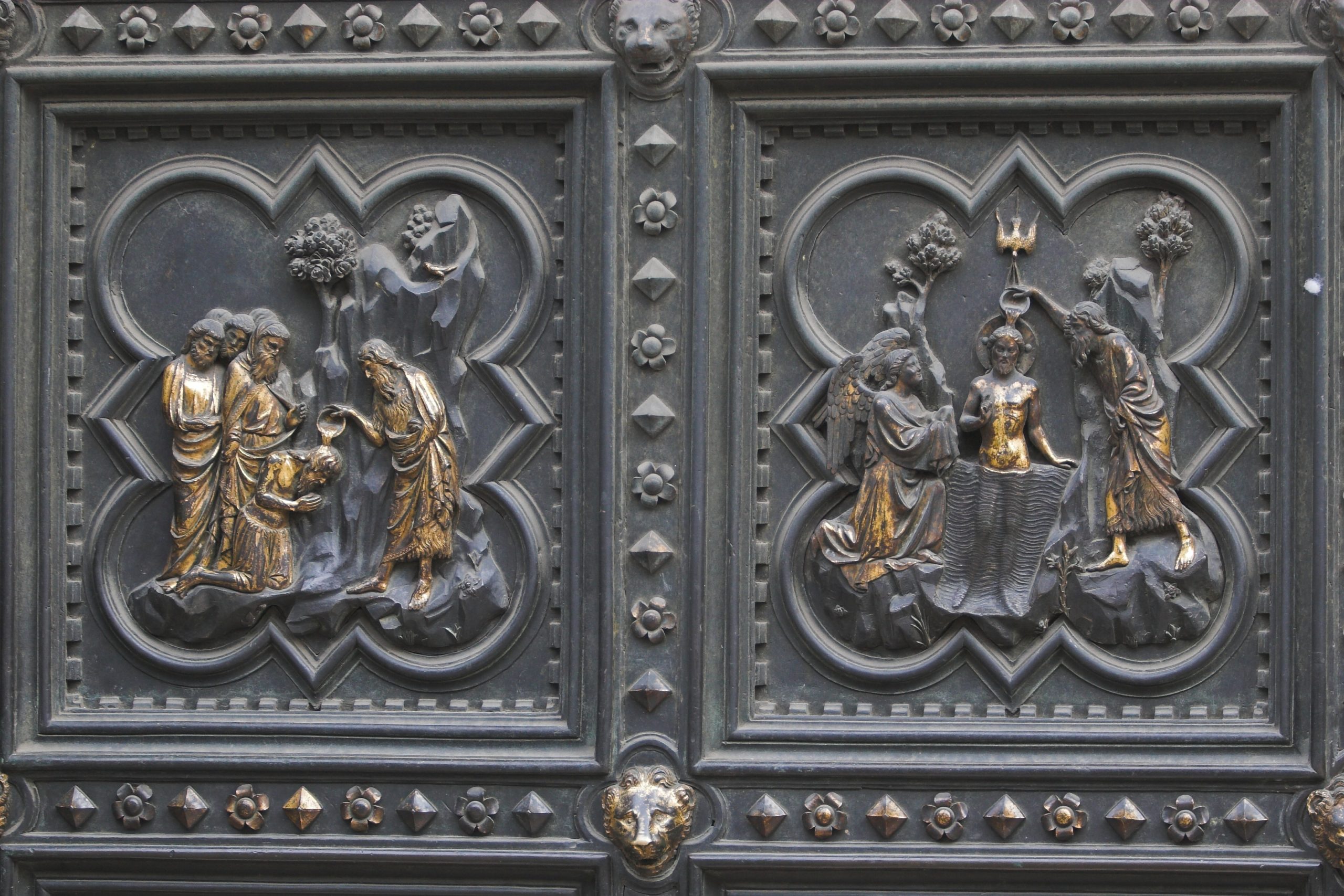
- In 1401, after having narrowly won the competition with Brunelleschi, the 23 year old and inexperienced young goldsmith Lorenzo Ghiberti (1378-1455), is commissioned by the Calima Guild to decorate the doors which are today the North Gate. Ghiberti cast the bronze high reliefs using a method known as lost-wax casting, a technique that he had to reinvent entirely since it was lost since the fall of the Roman Empire. One of the reasons Ghiberti won the contest, was that his technique was so advanced that it required 20 % less (7 kg per panel) bronze than that of his competitors, bronze being a dense material far more costly than marble. His technique, applied to the entire decoration of the North Gate, as compared to his competitors, would save some estimated 100 kg of bronze. And since in 1401, with the plague regularly hitting Florence, economic conditions were poor, even the wealthy Calimala took into account the total costs of the program.
The bronze doors are comprised of 28 panels, with 20 panels depicting the life of Christ from the New Testament. The 8 lower panels show the four Evangelists and the Church Fathers Saint Ambrose, Saint Jerome, Saint Gregory, and Saint Augustine. The construction took 24 years.
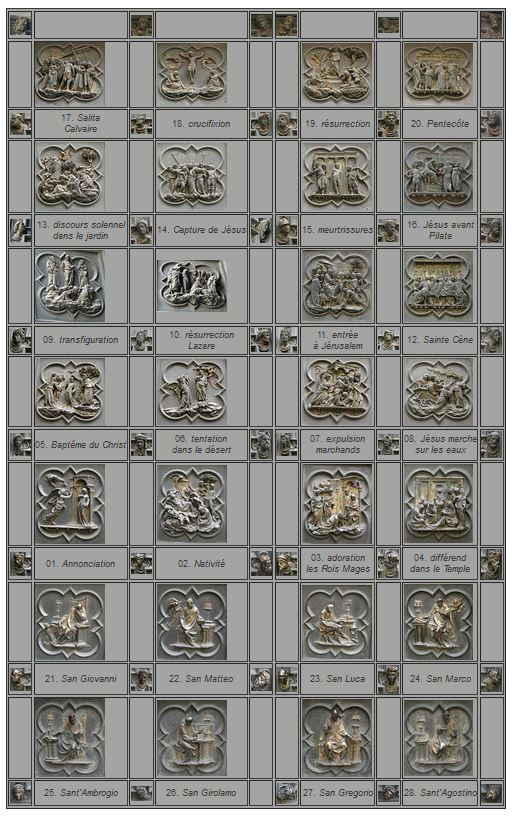

- In 1424, Ghiberti, at age 46, was given—unusually, with no competition—the task of also creating the East Gate. Only in 1452 did Ghiberti, then seventy-four years old, install the last bronze panels, since construction lasted this time 27 years! According to Giorgio Vasari (1511-1574), Michelangelo Buonarroti (1475-1564) later judged them « so beautiful they would grace the entrance to Paradise ».
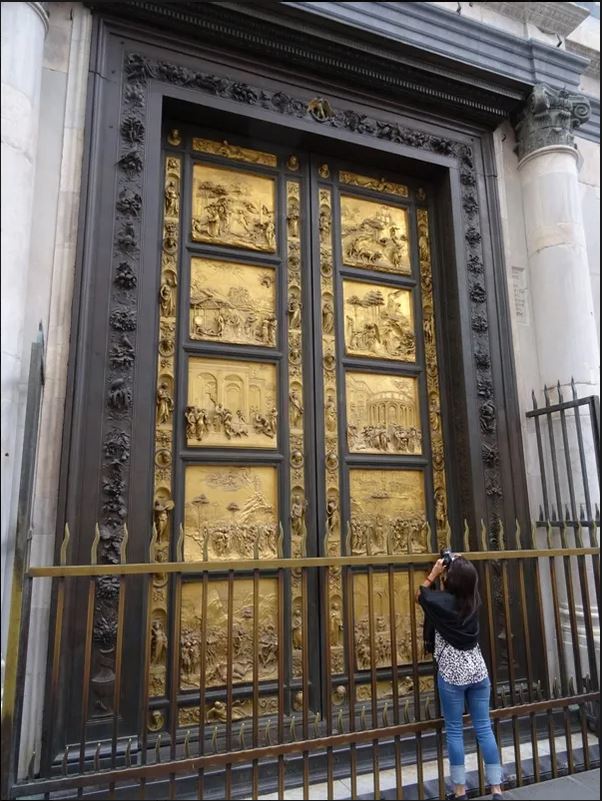
Over two generations, a bevy of well paid assistants and pupils were trained by Ghiberti, including exceptional artists, such as Luca della Robbia, Donatello, Michelozzo, Benozzo Gozzoli, Bernardo Cennini, Paolo Uccello, Andrea del Verrocchio and Ghiberti’s sons, Vittore and Tommaso. And over time, the seventeen-foot-tall, three-ton bronze doors became an icon of the Renaissance, one of the most famous works of art in the world.
In 1880, the French sculptor Auguste Rodin was inspired by it for his own Gates of Hell on which he worked for 38 year
Revolution

Of utmost interest for our discussion here is the dramatic shift in conception and design of the bronze relief sculptures that occurred between the North and the East Gates, because it reflects how bot the artist as well as his patrons used the occasion to share with the broader public their newest ideas, inventions and exciting discoveries.
The themes of the North Gate of 1401 were inspired by scenes from the New Testament, except for the panel made by Ghiberti, « The Sacrifice of Isaac », which had won him the selection competition the same year. To complete the ensemble, it was therefore only logical that the East Gate of 1424 would take up the themes of the Old Testament.
Originally, it was the scholar and former chancellor of Florence Leonardo Bruni (1369-1444) who planned an iconography quite similar to the two previous doors. But, after heated discussions, his proposal was rejected for something radically new. Instead of realizing 28 panels, it was decided, for aesthetic reasons, to reduce the number of panels to only 10 much larger square reliefs, between borders containing statuettes in niches and medallions with busts.

Hence, since each of the 10 chapters of the Old Testament contains several events, the total number of scenes illustrated, within the 10 panels has risen to 37 and all appear in perspective :
- Adam and Eve (The Creation of Man)
- Cain and Abel (Jalousie is the origin of Sin)
- Noah (God’s punishment)
- Abraham and Isaac (God is just)
- Jacob and Esau
- Joseph
- Moses
- Joshua
- David (Good commandor)
- Solomon and the Queen of Sheba
The general theme is that of salvation based on Latin and Greek patristic tradition. Very shocking for the time, Ghiberti places in the center of the first panel the creation of Eve, that of Adam appearing at the bottom left.
After the first three panels, focusing on the theme of sin, Ghiberti began to highlight more clearly the role of God the Savior and the foreshadowing of Christ’s coming. Subsequent panels are easier to understand. One example is the panel with Isaac, Jacob and Esau where the figures are merged with the surrounding landscape so that the eye is led toward the main scene represented in the top right.
Many of the sources for these scenes were written in ancient Greek, and since knowledge of Greek at that time was not so common, it appears that Ghiberti’s “theological advisor” was Ambrogio Traversari (1386-1439), with whom he had many exchanges.
Traversari was a close friend of Nicolas of Cusa (1401-1464), a protector of Piero della Francesca (1412-1492) and a key organizer of the Ecumenical Council of Florence of 1438-1439, which attempted to put an end to the schism separating the Church of the East from that of the West.
Perspective



The bronze reliefs, known for their vivid illusion of deep space in relief, are one of the revolutionary events that epitomize the Renaissance. In the foreground are figures in high relief, which gradually become less protruding thereby exploiting the full illusionistic potential of the stiacciato technique later brought to its high point by Donatello. Using this form of “inbetweenness”, they integrate in one single image, what appears both as a painting, a low relief as well as a high relief. Or maybe one has to look at it another way: these are flat images traveling gradually from a surface into the full three dimensions of life, just as Ghiberti, in one of the first self-portraits of art history, reaches his head out of a bronze medal to look down on the viewers. The artist desired much more than perspective, he wanted breathing space!
This new approach will influence Leonardo Da Vinci (1452-1517). As art historian Daniel Arasse points out :
(…) It was in connection with the practice of Florentine bas-relief, that of Ghiberti at the Gate of Paradise (…) that Leonardo invented his way of painting. As Manuscript G (folio 23b) would much later state, ‘the field on which an object is painted is a capital thing in painting. (…) The painter’s aim is to make his figures appear to stand out from the field’ – and not, one might add, to base his art on the alleged transparency of that same field. It is by the science of shadow and light that the painter can obtain an effect of emergence from the field, an effect of relief, and not by that of the linear perspective.
Donatello

At the beginning of the 15th century, several theoretical approaches existed and eventuall contradicted each other. Around 1423-1427, the talentful sculptor Donatello, a young collaborator of Ghiberti, created his Herod’s Banquet, a bas-relief in the stiacciato technique for the baptismal font of the Siena Baptistery.
In this work, the sculptor deploys a harmonious perspective with a single central vanishing point. Around the same time, in Florence, the painter Massacchio (1401-1428) used a similar construction in his fresco The Trinity.
As we will see, Ghiberti, starting from the anatomy of the eye, opposed such an abstract approach in his works as well as in his writings and explored, as early as 1401, other geometrical models, called « binocular ». (see below).

Christ among the Doctors, Ghiberti, before 1424.

Christ among the Doctors, Ghiberti, before 1424.
Then, as far as our knowledge reaches, in 1407, Brunelleschi had conducted several experiments on this question, most likely based on the ideas presented by another friend of Cusa, the Italian astronomer Paolo dal Pozzo Toscanelli (1397-1482), in the latter’s now lost treaty Della Prospettiva. What we do know is that Brunelleschi sought above all to demonstrate that all perspective is an optical illusion.
Finally, it was in 1435, that the humanist architect Leon Baptista Alberti (1406-1472), in his treatise Della Pictura, attempted, on the basis of Donatello’s approach, to theorize single vanishing point perspective as a representation of a harmonious and unified three-dimensional space on a flat surface. Noteworthy but frustrating for us today is the fact that Alberti’s treatise doesn’t contain any illustrations.

However, Leonardo, who read and studied Ghiberti’s writings on, would use the latter’s arguments to indicate the limits and even demonstrate the dysfunctionality of Alberti’s “perfect” perspective construction especially when one goes beyond a 30 degres angle.
In the Codex Madrid, II, 15 v. da Vinci realizes that « as such, the perspective offered by a rectilinear wall is false unless it is corrected (…) ».
Perspectiva artificialis versus perspectiva naturalis

Alberti’s “perspectiva artificialis” is nothing but an abstraction, necessary and useful to represent a rational organization of space. Without this abstraction, it is fairly impossible to define with mathematical precision the relationships between the appearance of objects and the receding of their various proportions on a flat screen: width, height and depth.
From the moment that a given image on a flat screen was thought about as the intersection of a plane cutting a cone or pyramid, a method emerged for what was mistakenly considered as an “objective” representation of “real” three dimensional space, though it is nothing but an “anamorphosis”, i.e. a tromp-l’oeil or visual illusion.
What has to be underscored, is that this construction does away with the physical reality of human existence since it is based on an abstract construct pretending:
- that man is a single eyed cyclops;
- that vision emanates from one single point, the apex of the visual pyramid;
- that the eye is immobile;
- that the image is projected on a flat screen rather than on a curved retina.
Slanders and gossip
The crucial role of Ghiberti, an artist which “Ghiberti expert” Richard Krautheimer mistakenly presents as a follower of Alberti’s perspectiva artificialis, has been either ignored or downplayed.
Ghiberti’s unique manuscript, the three volumes of the Commentarii, which include his autobiography and which established him as the first modern historian of the fine arts, is not even fully translated into English or French and was only published in Italian in 1998.
Today, because of his attention to minute detail and figures « sculpted » with wavy and elegant lines, as well as the variety of plants and animals depicted, Ghiberti is generally presented as “Gothic-minded”, and therefore “not really” a Renaissance artist!
Giorgio Vasari, often acting as the paid PR man of the Medici clan, slanders Ghiberti by saying he wrote « a work in the vernacular in which he treated many different topics but arranged them in such a fashion that little can be gained from reading it. »
Admittedly, tension among humanists, was not uncommon. Self-educated craftsmen, such as Ghiberti and Brunelleschi on the one side, and heirs of wealthy wool merchants, such as Niccoli on the other side, came from entirely different worlds. For example, according to a story told by Guarino Veronese in 1413, Niccoli greeted Filippo Brunelleschi haughtily: « O philosopher without books, » to which Filippo replied with his legendary irony: « O books without philosopher ».
For sure, the Commentarii, are not written according to the rhetorical rules of those days. Written at the end of Ghiberti’s life, they may have simply been dictated to a poorly trained clerk who made dozens of spelling errors.
The humanists

The Commentarii does reveal a highly educated author and a thinker having profound knowledge of many classical Greek and Arab thinkers. Ghiberti was not just some brilliant handcraft artisan but a typical “Renaissance man”.
In dialogue with Bruni, Traversari and the “manuscript hunter” Niccolo Niccoli, Ghiberti, who couldn’t read Greek but definitely knew Latin, was clearly familiar with the rediscovery of Greek and Arab science, a task undertaken by Boccaccio’s and Salutati’s “San Spirito Circle” whose guests (including Bruni, Traversari, Cusa, Niccoli, Cosimo di Medici, etc.) later would convene every week at the Santa Maria degli Angeli convent. Ghiberti exchanges moreover with Giovanni Aurispa, a collaborator of Traversari who brought back from Byzantium, years before Bessarion, the whole of Plato’s works to the West.
Amy R. Bloch, in her well researched study Lorenzo Ghiberti’s Gates of Paradise, Humanism, History, and Artistic Philosophy in the Italian Renaissance (2016), writes that « Traverari and Niccoli can be tied directly to the origins of the project for the Gates and were clearly interested in sculptural commissions being planned for the Baptistery. On June 21, 1424, after the Calima requested from Bruni his program for the doors, Traversari wrote to Niccoli acknowledging, in only general terms, Niccoli’s ideas for the stories to be included and mentioning, without evident disapproval, that the guild had instead turned to Bruni for advice. »
Palla Strozzi
Ghiberti’s patron, sometimes advisor, and close associate was Palla Strozzi (1372-1462), who, besides being the the richest man in Florence with a gross taxable assets of 162,925 florins in 1427, including 54 farms, 30 houses, a banking firm with a capital of 45,000 florins, and communal bonds, was also a politician, a writer, a philosopher and a philologist whose library contained close to 370 volumes in 1462.
Just as Traversari and Bruni, Strozzi learned Latin and studied Greek under the direction of the Byzantine scholar Manuel Chrysoloras, invited to Florence by Salutati.
Ghiberti’s close relationship with Strozzi, writes Bloch, « gave him access to his manuscripts and, as importantly, to Strozzi’s knowledge of them. »
But there was more. « The relationship between Ghiberti and Palla Strozzi was so close that, when Palla went to Venice in 1424 as one of two Florentine ambassadors charged with negociating an alliance with the Venetians, Ghiberti accompanied him in his retinue. »
Strozzi was known as a real humanist, always looking to preserve peace while strongly opposing oligarchical rule, both in Florence as in Venice.
In fact it was Palla Strozzi, not Cosimo de’ Medici, who first set in motion plans for the first public library in Florence, and he intended for the sacristy of Santa Trinita to serve as its entryway. While Palla’s library was never realized due to the dramatic political conflict knows as the Albizzi Coup that led to his exile in 1434, Cosimo who got a free hand to rule over Florence, would make the library project his own.
A bold statement
Ghiberti begins the Commentarii with a bold and daring statement for a Christian man in a Christian world, about how the art of antiquity came to be lost:
The Christian faith was victorious in the time of Emperor Constantine and Pope Sylvester. Idolatry was persecuted to such an extent that all the statues and pictures of such nobility, antiquity an perfection were destroyed and broken in to pieces. And with the statues and pictures, the theoretical writings, the commentaries, the drawing and the rules for teaching such eminent and noble arts were destroyed.
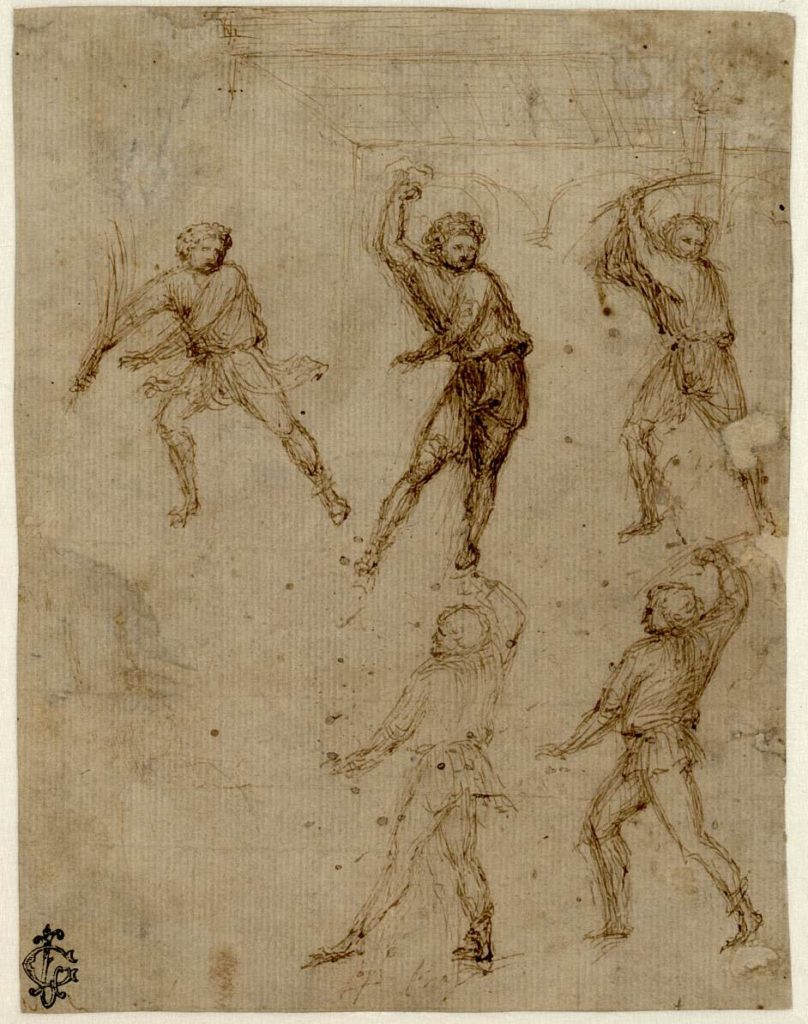
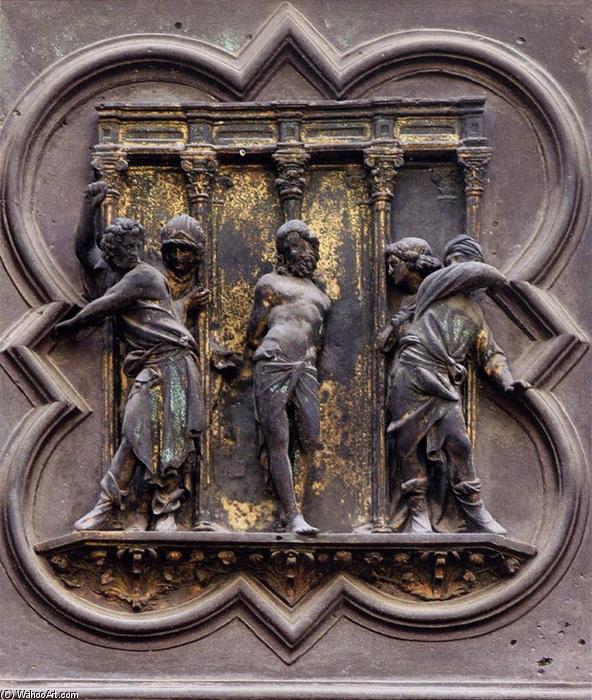

Ghiberti understood the importance of multidisciplinarity for artists. According to him, “sculpture and painting are sciences of several disciplines nourished by different teachings”.
In book I of his Commentarii, Ghiberti gives a list of the 10 liberal arts that the sculptor and the painter should master : philosophy, history, grammar, arithmic, astronomy, geometry, perspective, theory of drawing, anatomy and medecine and underlines that the necessity for an artist to assist at anatomical dissections.
As Amy Bloch underscores, while working on the Gates, in the intense process of visualizing the stories of God’s formation of the world and its living inhabitants, Ghiberti’s engagement « stimulated in him an interest in exploring all types of creativity — not only that of God, but also that of nature and of humans — and led him to present in the opening panel of the Gates of Paradise (The creation of Adam and Eve) a grand vision of the emergence of divine, natural, and artistic creation. »

The inclusion of details evoking God’s craftmanship, says Bloch, « recalls similes that liken God, as the maker of the world, to an architect, or, in his role as creator of Adam, to a sculptor or painter. Teh comparison, which ultimately derives from the architect-demiurge who creates the world in Plato’s Timaeus, appears commonly in medieval Jewish and Christian exegesis. »
Philo of Alexandria wrote that man was modeled « as by a potter » and Ambrose metaphorically called God a « craftsman (artifex) and a painter (pictor) ». Consequently, if man is « the image of God » as says Augustine and the model of the « homo faber – man producer of things », then, according to Salutati, « human affairs have a similarity to divine ones ».
The power of vision and the composition of the Eye
Concerning vision, Ghiberti writes:
I, O most excellent reader, did not have to obey to money, but gave myself to the study of art, which since my childhood I have always pursued with great zeal and devotion. In order to master the basic principles I have sought to investigate the way nature functions in art; and in order that I might be able to approach her, how images come to the eye, how the power of vision functions, how visual [images] come, and in what way the theory of sculpture and painting should be established.
Now, any serious scholar, having worked through Leonardo’s Notebooks, who then reads Ghiberti’s I Commentarii, immediately realizes that most of Da Vinci’s writings were basically comments and contributions about things said or answers to issues raised by Ghiberti, especially respecting the nature of light and optics in general. Leonardo’s creative mindset was a direct outgrowth of Ghiberti’s challenging world outlook.

In Commentario 3, 6, which deals with optics, vision and perspective, Ghiberti, opposing those for whom vision can only be explained by a purely mathematical abstraction, writes that “In order that no doubt remains in the things that follow, it is necessary to consider the composition of the eye, because without this one cannot know anything about the way of seeing.” He then says, that those who write about perspective don’t take into account “the eye’s composition”, under the pretext that many authors would disagree.
Ghiberti regrets that despite the fact that many “natural philosophers” such as Thales, Democritus, Anaxagoras and Xenophanes have examined the subject along with others devoted to human health such as “Hippocrates, Galen and Avicenna”, there is still so much confusion.
Indeed, he says, “speaking about this matter is obscure and not understood, if one does not have recourse to the laws of nature, because more fully and more copiously they demonstrate this matter.”
Avicenna, Alhazen and Constantine
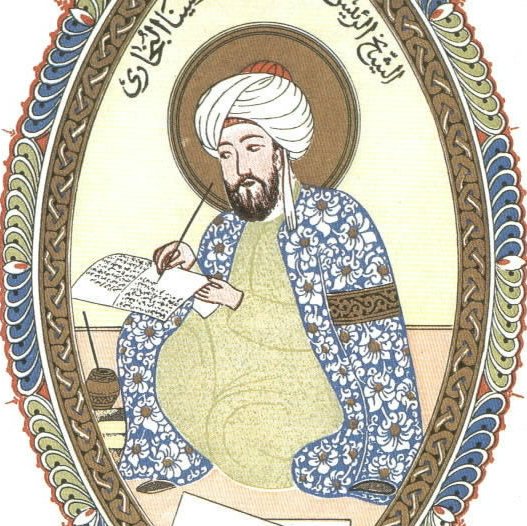
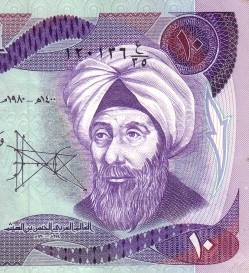
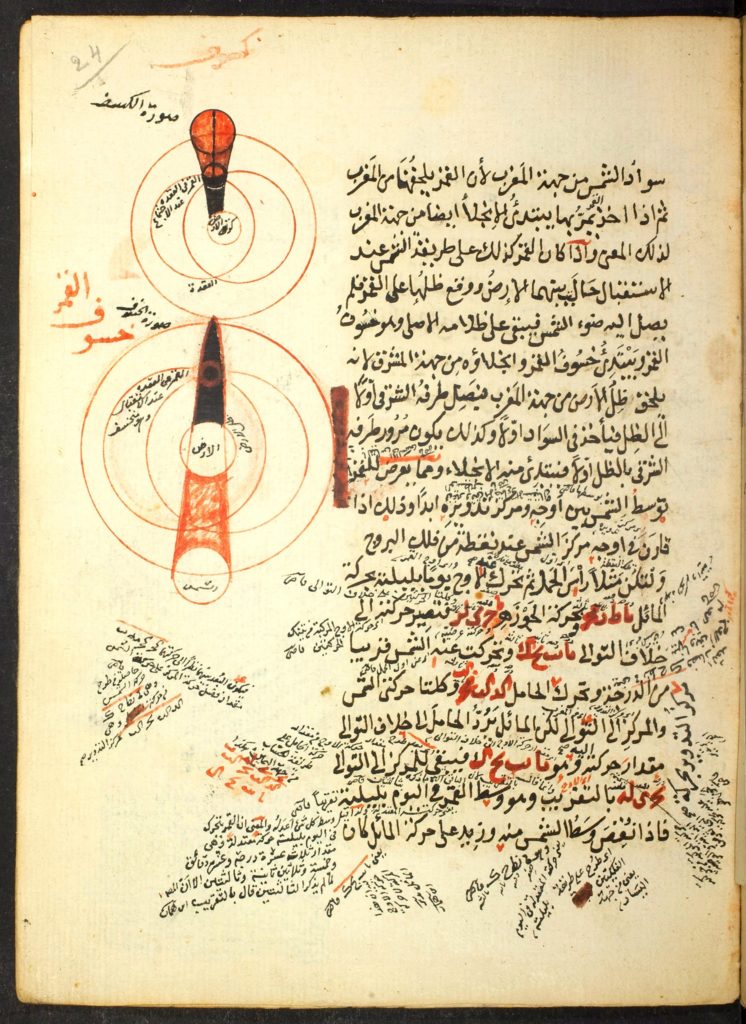
Therefore, says Ghiberti:
it is necessary to affirm some things that are not included in the perspective model, because it is very difficult to ascertain these things but I will try to clarify them. In order not to deal superficially with the principles that underlie all of this, I will deal with the composition of the eye according to the writings of three authors, Avicenna (Ibn Sina), in his books, Alhazen (Ibn al Haytham) in his first volume on perspective (Optics), and Constantine (the Latin name of the Arab scholar and physician Qusta ibn Luqa) in his ‘First book on the Eye’; for these authors suffice and deal with much certainty in these subjects that are of interest to us.
This is quite a statement! Here we have “the” leading, founding figure of the Italian and European Renaissance with its great contribution of perspective, saying that to get any idea about how vision functions, one has to study three Arab scientists: Ibn Sina, Ibn al Haytham and Qusta ibn Luqa ! Cultural Eurocentrism might be one reason why Ghiberti’s writings were kept in the dark.
Ibn al-Haytham (Alhazen) made important contributions to opthalmology and improved upon earlier conceptions of the processes involved in vision and visual perception in his Treatise on Optics (1021), which is known in Europe as the Opticae Thesaurus. Following his work on the camera oscura (darkroom) he was also the first to imagine that the retina (a curved surface), and not the pupil (a point) could be involved in the process of image formation.
Avicenna, in the Canon of Medicine (ca. 1025), describes sight and uses the word retina (from the Latin word rete meaning network) to designate the organ of vision.
Later, in his Colliget (medical encyclopedia), Ibn Rushd (Averroes, 1126-1198) was the first to attribute to the retina the properties of a photoreceptor.
Avicenna’s writings on anatomy and medical science were translated and circulating in Europe since the XIIIth century, Alhazen’s treatise on optics, which Ghiberti quotes extensively, had just been translated into Italian under the title De li Aspecti.
It is now recognized that Andrea del Verrocchio, whose best known pupil was Leonardo da Vinci (1452-1517) was himself one of Ghiberti’s pupils. Unlike Ghiberti, who mastered Latin, neither Verrocchio nor Leonardo mastered a foreign language.
What is known is that while studying Ghiberti’s Commentarii, Leonardo had access in Italian to a series of original quotations from the Roman architect Vitruvius and from Arab scientists such as Avicenna, Alhazen, Averroes and from those European scientists who studied Arab optics, notably the Oxford Fransciscans Roger Bacon (1214-1294), John Pecham (1230-1292) and the Polish monk working in Padua, Erazmus Ciolek Witelo (1230-1275), known by his Latin name Vitellion.

As stressed by Professor Dominque Raynaud, Vitellion introduces the principle of binocular vision for geometric considerations.
He gives a figure where we see the two eyes (a, b) receiving the images of points located at equal distance from the hd axis.
He explains that the images received by the eyes are different, since, taken from the same side, the angle grf (in red) is larger than the angle gtf (in blue). It is necessary that these two images are united at a certain point in one image (Diagram).
Where does this junction occur? Witelo says: « The two forms, which penetrate in two homologous points of the surface of the two eyes, arrive at the same point of the concavity of the common nerve, and are superimposed in this point to become one ».
The fusion of the images is thus a product of the internal mental and nervous activity.
The great astronomer Johannes Kepler (1571-1630) will use Alhazen’s and Witelo’s discoveries to develop his own contribution to optics and perspective. “Although up to now the [visual] image has been [understood as] a construct of reason,” Kepler observes in the fifth chapter of his Ad Vitellionem Paralipomena (1604), “henceforth the representations of objects should be considered as paintings that are actually projected on paper or some other screen.” Kepler was the first to observe that our retina captures an image in an inverted form before our brain turns it right side up.
Out of this Ghiberti, Uccello and also the Flemish painter Jan Van Eyck, in contact with the Italians, will construct as an alternative to one cyclopic single eye perspective revolutionary forms of “binocular” perspective while Leonardo and Louis XI’ court painter Jean Fouquet will attempt to develop curvilinear and spherical space representations.
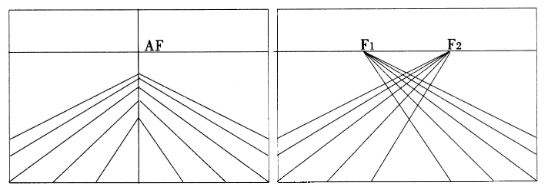

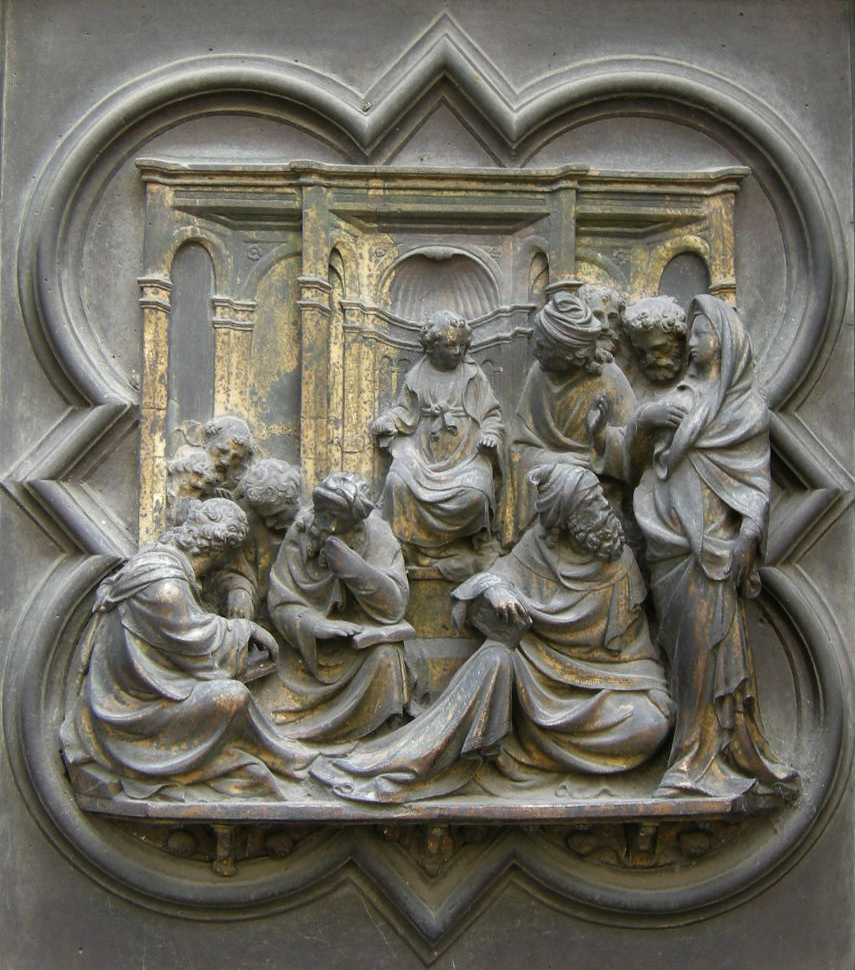

In China, eventually influenced by Arab optical science breakthrough’s, forms of non-linear perspective, that integrate the mobility of the eye, will also make their appearance during the Song Dynasty.
Light
Ghiberti will add another dimension to perspective: light. One major contribution of Alhazen was his affirmation, in his Book of Optics, that opaque objects struck with light become luminous bodies themselves and can radiate secondary light, a theory that Leonardo will exploit in his paintings, including in his portraits.
Already Ghiberti, in the way he treats the subject of Isaac, Jacob and Esau (Figure), gives us an astonishing demonstration of how one can exploit that physical principle theorized by Alhazen. The light reflected by the bronze panel, will strongly differ according to the angle of incidence of the arriving rays of light. Arriving either from the left of from the right side, in both cases, the Ghiberti’s bronze relief has been modeled in such a way that it magnificently strengthens the overall depth effect !

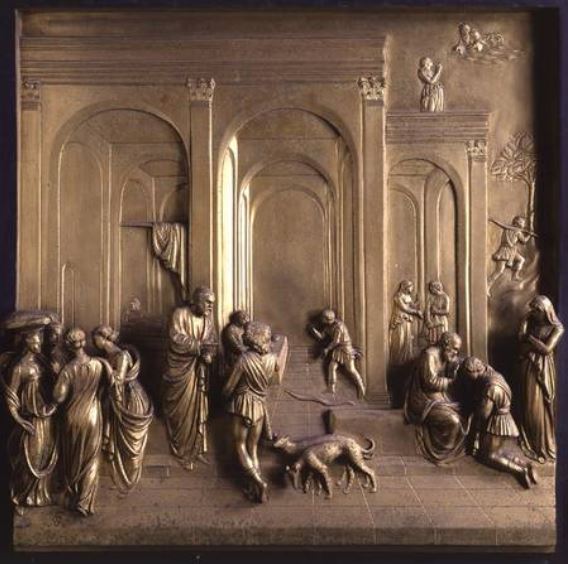
While the experts, especially the neo-Kantians such as Erwin Panofsky or Hans Belting, say that these artists were “primitives” because applying the “wrong” perspective model, they can’t grasp the fact that they were in reality exploring a far “higher domain” than the mere pure mathematical abstraction promoted by the Newton-Galileo cult that became the modern priesthood ruling over “science”.
Much more about all of this can and should be said. Today, the best way to pay off the European debt to “Arab” scientific contributions, is to reward not just the Arab world but all future generations with a better future by opening to them the “Gates of Paradise”.
See all of Ghiberti’s works at the WEB GALLERY OF ART
Short Biography
- Arasse, Daniel, Léonard de Vinci, Hazan, 2011;
- Avery, Charles, La sculpture florentine de la Renaissance, Livre de poche, 1996, Paris;
- Belting, Hans, Florence & Baghdad, Renaissance art and Arab science, Harvard University Press, 2011;
- Bloch, Amy R., Lorenzo Ghiberti’s Gates of Paradise; Humanism, History and Artistic Philosophy in the Italian Renaissance, Cambridge University Press, 2016, New York;
- Borso, Franco et Stefano, Uccello, Hazan, Paris, 2004 ;
- Butterfield, Andrew, Verrocchio, Sculptor and painter of Renaissance Florence, National Gallery, Princeton University Press, 2020 ;
- Butterfield, Andrew, Art and Innovation in Ghiberti’s Gates of Paradise, High Museum of Art, Yale University Press, 2007;
- Kepler, Johannes, Paralipomènes à Vitellion, 1604, Vrin, 1980, Paris;
- Krautheimer, Richard and Trude, Lorenzo Ghiberti, Princeton University Press, New Jersey, 1990;
- Martens, Maximiliaan, La révolution optique de Jan van Eyck, dans Van Eyck, Une révolution optique, Hannibal – MSK Gent, 2020.
- Pope-Hennessy, John, Donatello, Abbeville Press, 1993 ;
- Radke, Gary M., Lorenzo Ghiberti: Master Collaborator; The Gates of Paradise, Lorenzo Ghiberti’s Renaissance Masterpiece, High Museum of Atlanta and Yale University Press, 2007;
- Rashed, Roshi, Geometric Optics, in History of Arab Sciences, edited by Roshdi Rashed, Vol. 2, Mathematics and physics, Seuil, Paris, 1997.
- Raynaud, Dominique, L’hypothèse d’Oxford, essai sur les origines de la perspective, PUF, 1998, Paris.
- Raynaud, Dominique, Ibn al-Haytham on binocular vision: a precursor of physiological optics, Arabic Sciences and Philosophy, Cambridge University Press (CUP), 2003, 13, pp. 79-99.
- Raynaud, Dominique, Perspective curviligne et vision binoculaire. Sciences et techniques en perspective, Université de Nantes, Equipe de recherche: Sciences, Techniques, et Sociétés, 1998, 2 (1), pp.3-23.;
- Vereycken, Karel, interview with People’s Daily: Leonardo Da Vinci’s « Mona Lisa » resonates with time and space with traditional Chinese painting, 2019.
- Vereycken, Karel, Uccello, Donatello, Verrocchio and the art of military command, 2022.
- Vereycken, Karel, The Invention of Perspective, Fidelio, 1998.
- Vereycken, Karel, Van Eyck, un peintre flamand dans l’optique arabe, 1998.
- Vereycken, Karel, Mutazilism and Arab astronomy, two bright stars in our firmament, 2021.
- Walker, Paul Robert, The Feud That Sparked the Renaissance, How Brunelleschi and Ghiberti changed the World, HarperCollins, 2002.
Uccello, Donatello, Verrocchio and the art of military command

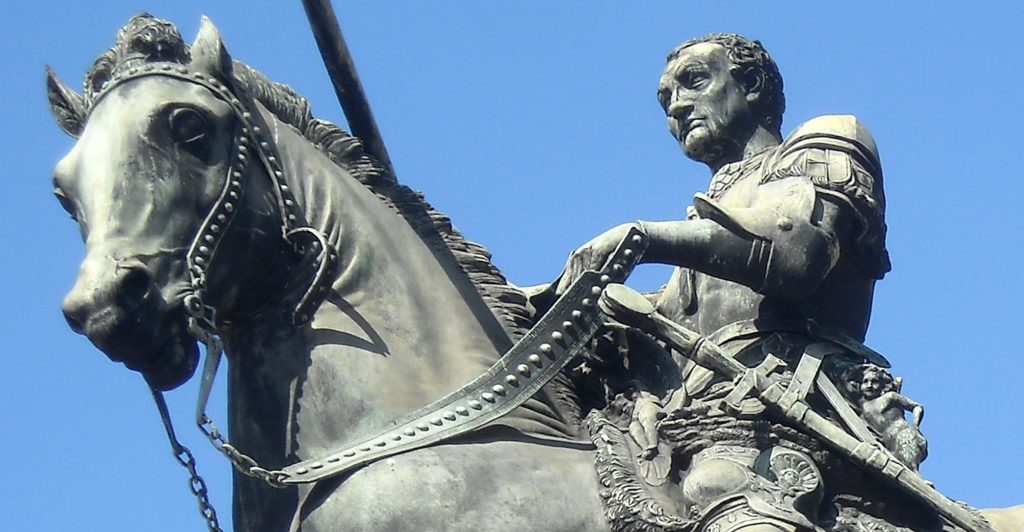
Uccello, Donatello, Verrocchio and the art of military command. An inquiry into the key events and artistic achievements that created the Renaissance. By Karel Vereycken, Paris.
Prologue

If there is still a lot to say, write and learn about the great geniuses of the European Renaissance, it is also time to take an interest in those whom the historian Georgio Vasari condescendingly called « transitional figures ».
How can one measure the contributions of Pieter Bruegel the Elder without knowing Pieter Coecke van Aelst? How can we value Rembrandt’s work without knowing Pieter Lastman? How did Raphaelo Sanzio innovate in relation to his master Perugino?
In 2019, an exceptional exhibition on Andrea Del Verrocchio (1435-1488), at the National Gallery in Washington, D.C., highlighted his great achievements, truly inspiring outbursts of great beauty that his pupil Leonardo da Vinci (1452-1519) would theorize and put to his greatest advantage.
The sfumato of Leonardo ? Verrochio is the pioneer, especially in the blurred features of portraits of women made with mixed techniques (pencil, chalk and gouache).

The joy of discovery
Leafing through the catalog of this exhibition, my joy got immense when I discovered (and to my knowledgne nobody else seems to have made this observation before me) that the enigmatic angel the viewer’s eye meets in Leonardo’s painting titled The Virgin on the Rocks (1483-1486) (Louvre, Paris), besides the movement of the body, is grosso modo a visual “quote” of the image of a terra cotta high relief (Louvre, Paris) attributed to Verrochio and “one of his assistants”, possibly even Leonardo himself, since the latter was training with the master as early as age seventeen ! The finesse of its execution and drapery also reminds us of the only known statue of Da Vinci, The Virgin with the laughing Child.

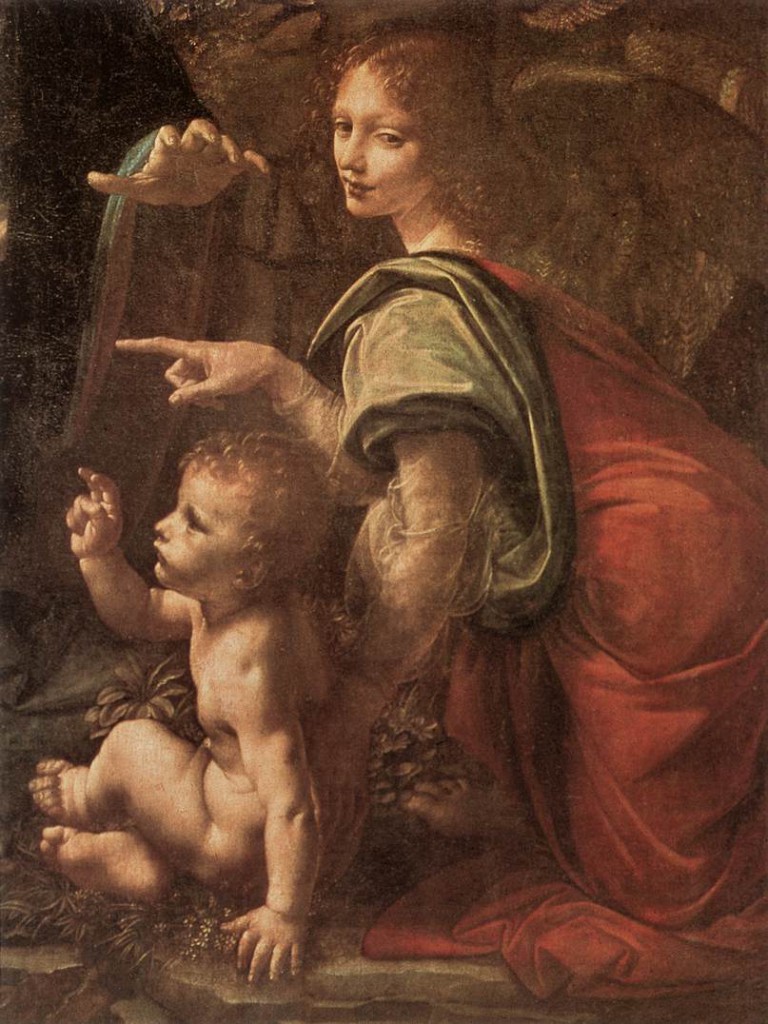
Many others made their beginnings in Verrocchio’s workshop, notably Lorenzo de Credi, Sandro Botticelli, Piero Perugino (Raphael’s teacher) and Domenico Ghirlandaio (Michelangelo’s teacher).
Coming out of the tradition of the great building sites launched in Florence by the great patron of the Renaissance, Cosimo de Medici for the realization of the doors of the Baptistery and the completion of the dome of Florence by Philippo Brunelleschi (1377-1446), Verrocchio conceived his studio as a true “polytechnic” school.
In Florence, for the artists, the orders flowed in. In order to be able to respond to all requests, Verrocchio, initially trained as a goldsmith, trained his students as craftsman-engineer-artists: drawing, calculation, interior decoration, sculpture, geology, anatomy, metal and woodworking, perspective, architecture, poetry, music and painting. A level of freedom and a demand for creativity that has unfortunately long since disappeared.
The Ghiberti legacy
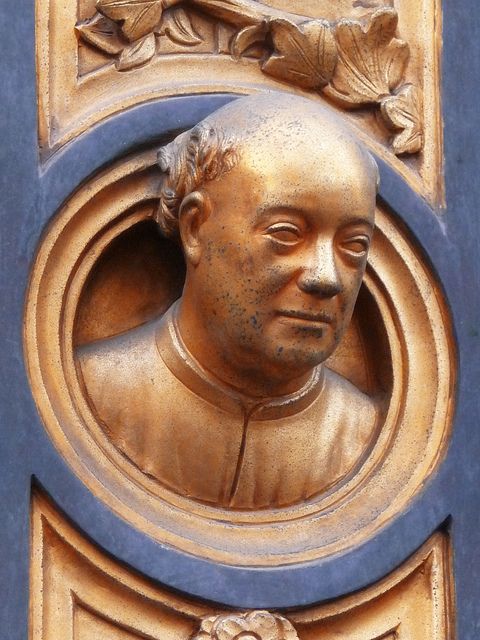
In painting, Verrocchio is said to have begun with the painter Fra Filippo Lippi (1406-1469). As for the bronze casting trade, he would have been, like Donatello, Masolino, Michelozzo, Uccello and Pollaiuolo, one of the apprentices recruited by Lorenzo Ghiberti (1378-1455) whose workshop, starting from 1401, over forty years, will be in charge of casting the bronze bas-reliefs of two of the huge doors of the Baptistery of Florence.
Others suggest that Verrocchio was most likely trained by Michelozzo, the former companion of Ghiberti who said up shop with Donatello. As a teenager, Donatello had accompanied Brunelleschi on their joint expeditions to Rome to investigate the legacy of Greek and Roman art, and not only the architectural legacy.
In reality, Verrocchio only perpetuated and developed the model of Ghiberti’s « polytechnic » studio, where he learned the art. An excellent craftsman, Ghiberti was also goldsmith, art collector, musician and humanist scolar and historian.
His genius is to have understood the importance of multidisciplinarity for artists. According to him « sculpture and painting are sciences of several disciplines nourished by different teachings ».
The ten disciplines that he considered important to train artists are grammar, philosophy, history, followed by perspective, geometry, drawing, astronomy, arithmetic, medicine and anatomy.
You can discover, says Ghiberti, only when you managed to isolate the object of your research from interfering factors, and you can discover by detaching oneself from a dogmatic system;
as the nature of things want it, the sciences hidden under artifices are not constituted so that the men with narrow chests can judge them.
Anticipating the type of biomimicry that will characterize Leonardo thereafter, Ghiberti affirms that he sought:
to discover how nature functioned and how he could approach it to know how the objects come to the eye, how the sight functions and in which way one has to practice sculpture and painting.
Ghiberti, who was familiar with some of the leading members of the circle of humanists led by Salutati and Traversari, based his own reflexions on optics on the authority of ancient texts, especially Arabic. He wrote:
But in order not to repeat in a superficial and superfluous way the principles that found all opinions, I will treat the composition of the eye particularly according to the opinions of three authors, namely Avicenna [Ibn Sina], in his books, Alhazen [Ibn al Haytam], in the first book of his perspective, and Constantine [Qusta ibn Luqa] in the first book on the eye; for these authors are sufficient and treat with more certainty the things that interest us.
Deliberately ignored (but copied) by Vasari, Ghiberti’s Commentaries are a real manuel for artists, written by an artist. Most interestingly, it is by reading Ghiberti’s Commentaries that Leonardo da Vinci became familiar with important Arab contributions to science, in particular the outstanding work of Ibn al Haytam (Alhazen) whose treatise on optics had just been translated from Latin into Italian under the title De li Aspecti, and is quoted at length by Ghiberti in his Commentario Terzio. Author A. Mark Smith suggests that, through Ghiberti, Alhazen’s Book of Optics
may well have played a central role in the development of artificial perspective in early Renaissance Italian painting.

Ghiberti’s comments are not extensive. However, for the pupils of his pupil Verrocchio, such as Leonardo, who didn’t command any foreign language, Ghiberti’s book did make available in italian a series of original quotes from the roman architect Vitruvius, arab scientists such as Alhazen), Avicenna, Averroes and those european scientists having studied arab optics, notably the Oxford fransciscans Roger Bacon, John Pecham and the Polish monk working in Padua, Witelo.
Finally, in 1412, Ghiberti, while busy coordinating all the works on the Gates of the Baptistry, was also the first Renaissance sculptor to cast a life-size statue in bronze, his Saint John the Baptist, to decorate Orsanmichele, the house of the Corporations in Florence.
Lost wax casting
However, in order to cast bronzes of such a size, the artists, considering the price of metal, would use the technique known as “lost wax casting”.

This technique consists of first making a model in refractory clay (A), covered with a thickness of wax corresponding to the thickness of the bronze thought necessary.
The model is then covered with a thick layer of wet plaster (B) which, as it solidifies, forms an outer mold. Finally, the very hot molten bronze, pored into the mold it penetrates by rods (J) provided for this purpose, will replace the wax.
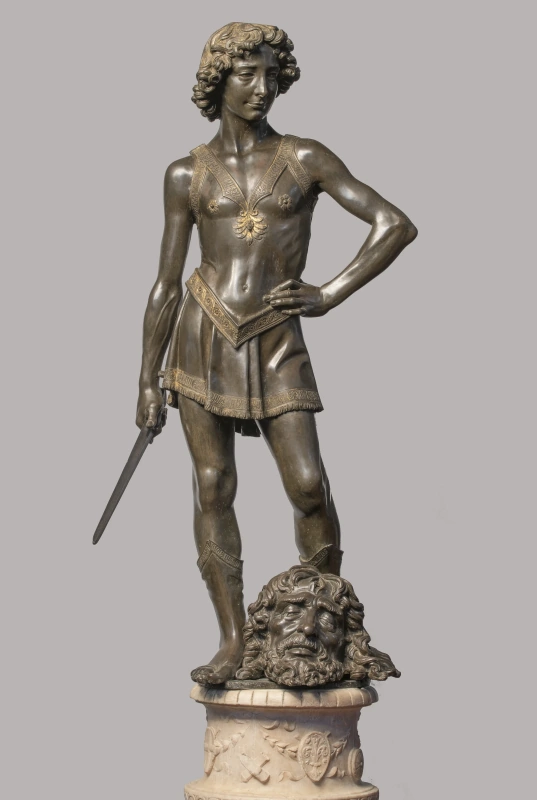
Finally, once the metal has solidified, the coating is broken. The details of the bronze (K) are then adjusted and polished (L) according to the artist’s choice.
This technique would become crucial for the manufacture of bells and cannons. While it was commonly used in Ifé in Africa in the 12th century for statuary, in Europe it was only during the Renaissance, with the orders received by Ghiberti and Donatello, that it was entirely reinvented.
In 1466, after the death of Donatello, it was Verrocchio’s turn to become the Medici’s sculptor in title for whom he produced a whole series of works, notably, after Donatello, his own David in bronze (Bargello National Museum, Florence).
If with this promotion his social ascendancy is certain, Verrocchio found himself facing the greatest challenge that any artist of the Renaissance could have imagined: how to equal or even surpass Donatello, an artist whose genius has never been praised enough?
Equestrian art
This being said, let us now approach the subject of the art of military command by comparing four equestrian monuments:
- Roman Emperor Marcus Aurelius on the Capitoline square in Rome (175 AD) ;
- Paolo Uccello’s fresco of John Hawkwood in the church of Santa Maria del Fiore in Florence (1436);
- Erasmo da Narni, known as “Gattamelata” (1446-1450), casted by Donatello in Padua.
- Bartolomeo Colleoni by Andrea del Verrocchio in Venice (1480-1488).
Equestrian statues appeared in Greece in the middle of the 6th century B.C. to honor the victorious riders in a race. From the Hellenistic period onward, they were reserved for the highest state figures, sovereigns, victorious generals and magistrates. In Rome, on the forum, they constituted a supreme honor, subject to the approval of the Senate. Apart from being bronze equestrian statues, each one is placed in a place where their troops fought.
While each statue is a reminder of the importance of military and political command, the way in which this responsibility is exercised is quite different.
Marcus Aurelius in Rome

Marcus Aurelius was born in Rome in 121 A.D., into a noble family of Spanish origin. He was the nephew of the emperor Hadrian. After the death of Marcus Aurelius’ father, Hadrian entrusted him to his successor Antonin. The latter adopts and gives him an excellent education. He was initiated early in philosophy by his master Diognetus.
Interested in the stoics, he adopted for a while their lifestyle, sleeping on the ground, wearing a rough tunic, before he was dissuaded by his mother.
He went to Athens in 175 A.D. and became a promotor of philosophy. He helps financially the philosophers and the rhetoricians by granting them a fixed salary. Concerned with pluralism, he supported the Platonic Academy, the Lyceum of Aristotle, the Garden of Epicurus and the Stoic Portico.
On the other hand, during his reign, persecutions against Christians were numerous. He saw them as troublemakers – since they refused to recognize the Roman gods, and as fanatics.

Erected in 175 A.D., the statue was entirely gilded. Its location in antiquity is unknown, but in the Middle Ages it stood in front of the Basilica of St. John Lateran, founded by Constantine, and the Lateran Palace, then the papal residence.
In 1538, Pope Paul III had the monument of Marcus Aurelius transferred to the Capitol, the seat of the city’s government. Michelangelo restored the statue and redesigned the square around it, one of the fanciest in Rome. It is undoubtedly the most famous equestrian statue, and above all the only one dating back to ancient Rome that has survived, the others having been melted down into coins or weapons…
If the statue survived, it is thanks to a misunderstanding: it was thought that it represented Constantine, the first Roman emperor to have converted to Christianity at the beginning of the 4th century, and it was out of the question to destroy the image of a Christian ruler.
Neither the date nor the circumstances of the commission are known.
But the presence of a defeated enemy under the right foreleg of the horse (attested by medieval testimonies and since lost), the emperor’s gesture and the shape of the saddle cloth, unusual in the Roman world, make us to belief that the statue commemorated Marcus Aurelius’ victories, perhaps on the occasion of his triumph in Rome in 176, or even after his death. Indeed, his reign (161-180) was marked by incessant wars to counter the incursions of Germanic or Eastern peoples on the borders of an Empire that was now threatened and on the defensive.
The horse, while not that large, but looking powerful, has been sculpted with great care and represented with realism. Its nostrils are strongly dilated, its lips pulled by the bit reveal its teeth and tongue.
One leg raised, he has just been stopped by his rider, who holds the reins with his left hand. Like him, the horse turns his head slightly to the right, a sign that the statue was made to be seen from that side. Part of his harness is preserved, but the reins have disappeared.
The size of the athletic rider nevertheless dominates that of a powerful horse that he rides without stirrups (accessories unknown to the Romans). He is dressed in a short tunic belted at the waist and a ceremonial cloak stapled on the right shoulder. It is a civil and not a military garment, adapted to a peaceful context. He is wearing leather shoes held together by intertwined straps.
The statue is striking for its size (424 cm high) and for the majesty it exudes. Without armor or weapons, eyes wide open and without emotion, the emperor raises his right arm. His authority derives above all from the function he embodies: he is the Emperor who protects his Empire and his people by punishing their enemies without mercy.
The fresco by Paolo Uccello
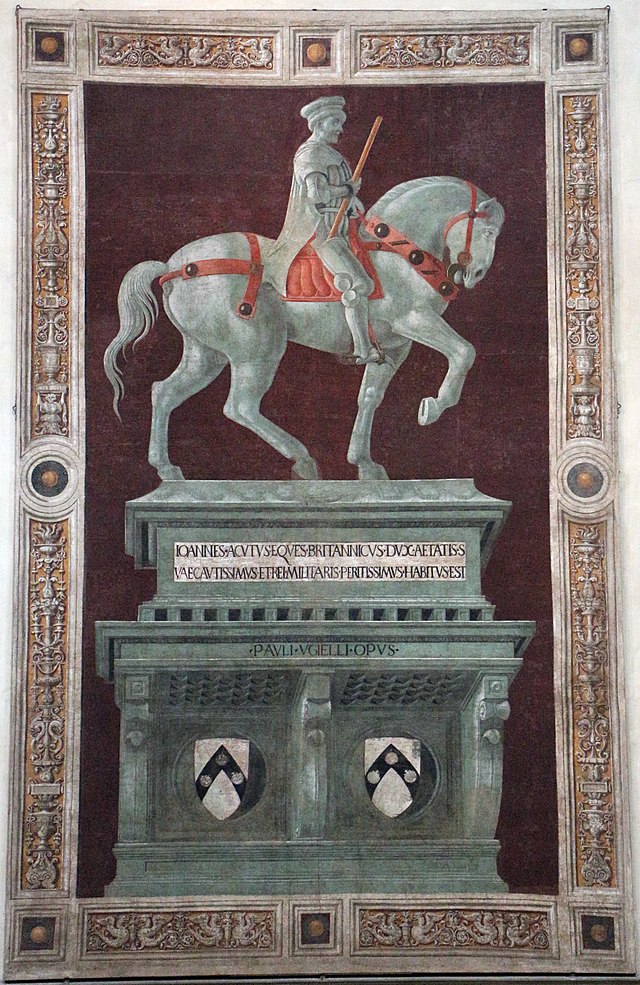
In 1436, at the request of Cosimo de’ Medici, the young Paolo Uccello was commissioned to paint a fresco depicting John Hawkwood (1323-1394), the son of an English tanner who had become a warlord during the Hundred Years’ War in France and whose name would be Italicized into Giovanno Acuto.
Serving the highest bidder, especially rival Italian cities, Hawkwood’s company of mercenaries was no slouch.
In Florence, although it may seem paradoxical, it was the humanist chancellor Coluccio Salutati (1331-1406) who put Hawkwood at the head of a regular army in the service of the Signoria.
This approach is not unlike that of Louis XI in France, who, in order to control the skinners and other cutthroats who were ravaging the nation, did not hesitate to discipline them by incorporating them into a standing army, the new royal army.
The humanists of the Renaissance, notably Leonardo Bruni (1370-1440) in his De Militia (1420), became aware of the curse of using mercenaries in conflicts and of the fact that only standing army, i.e. a permanent army formed of professionals and even better by citizens and maintained by a state or a city could guarantee a lasting peace.
Although Hawkwood faithfully protected the city for 18 years, his ugly “professionalism” as a mercenary was not unanimously accepted, to the point of inspiring the proverb “Inglese italianato è un diavolo Incarnato” (« An Italianized Englishman is a devil incarnate »).
Petrarch denounced him, Boccaccio tried in vain to mount a diplomatic offensive against him, St. Catherine of Sienna begged him to leave Italy, Chaucer met him and, no doubt, used him as a model for The Knight’s Tale (The Canterbury Tales).
All this will not prevent Cosimo, a member of the humanist conspiracy and a great patron of the arts, returning from exile, from wanting to honor him. But in the absence of the bronze equestrian statue (which had been promised to him…), Florence, will only offer him a fresco in the nave of Santa Maria del Fiore, that is to say under right under the cupola of the Duomo.

From the very beginning, Paolo Uccello’s fresco seems to have stirred quite a controversy. A preparatory drawing in the collections of Florence’s Uffizi Museum indicates the commander, more armed, taller, and, with his horse in a more military position. Uccello had originally depicted Hawkwood as « more threatening », with his baton raised and horse « at the ready ».
A recent ultraviolet study confirms the fact that the painter had originally depicted the condottiere armed from head to toe. In the final version, he wears a sleeveless jacket, the giornea, and a coat; only his legs and feet are protected by a piece of armor. The final version presents a less imposing rider, less warlike, more human and more individualized
In the dispute, it was not Uccello who was considered faulty, but his sponsors. Moreover, the painter was quickly given the task of redoing the fresco in a way deemed “more appropriate”.

Unfortunately, there is no record of the debates that must have raged among the officials of the church fabric (Opera Del Domo). What is certain is the fact that in the final version, visible today, the condottiere has been transformed from a warlord running a gang of mercenaries, into the image of philosopher-king whose only weapon is his commanding staff. At the bottom of the fresco, we can read in Latin: “Giovanno Acuto, British knight, who was in his time held as a very prudent general and very expert in military affairs.”
The position of the horse and the perspective of the sarcophagus have been changed from a simple profile to a di sotto in su view.
If this perspective is somewhat surrealistic and the pose of the horse, raising both legs on the same side, simply impossible, it remains a fact that Uccello’s fresco will set “the standards” of the ideal and impassive image of virtue and command that must embody the hero of the Renaissance: his goal is no longer to “win” a war (the objective of the mercenary), but to preserve the peace by preventing it (the objective of a philosopher-king or simply a wise head of state).
Paradigm shift


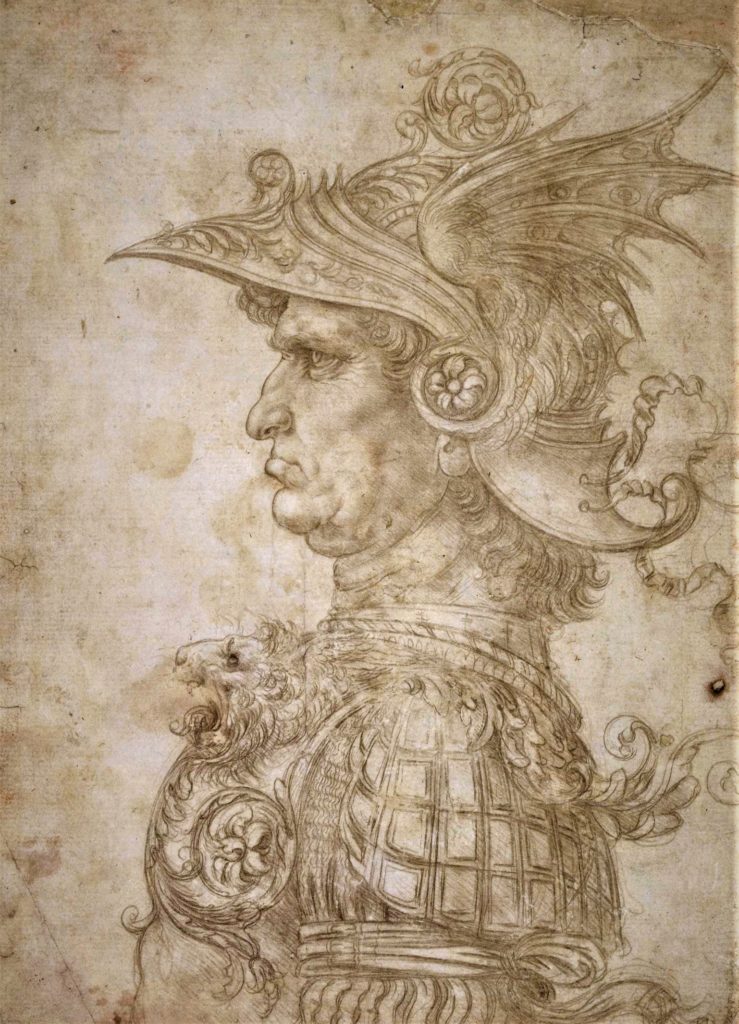
As such, one might say that Uccello’s fresco announces the “paradigm shift” marking the end of the age of perpetual feudal wars, to that of the Renaissance, that is to say to that of a necessary concord between sovereign nation-states whose security is indivisible, the security of one being the guarantee of the security of the other, a paradigm even more rigorously defined in 1648 at the Peace of Westphalia, when it made the agapic notion of the “advantage of the other” the basis of its success.
One historian suggests that the recommissioning of Uccello’s fresco was part of the « refurbishing » of the cathedral associated with its rededication as Santa Maria del Fiore by the humanist Pope Eugene IV in March 1436, determined to convince the Eastern and Western Churches to peacefully overcome their divisions and réunite as was attempted at the Council of Florence of 1437-1438 and for which the Duomo was central.
Interesting is the fact that Uccello’s fresco appeared at around the same time that Yolande d’Aragon and Jacques Coeur, who had his Italian connections, persuaded the French king Charles VII to put an end to the Hundred Years’ War by setting up a permanent, standing army.
In 1445, an ordinance was passed to discipline and rationalize the army in the form of cavalry units grouped into Compagnies d’Ordonnances, the first permanent army at the disposal, not of warlords or aristocrats, but of the King of France.
Donatello’s “Gattamelata” (1447-1453)

It was only some years later, in Padua, between 1447 and 1453, that Donatello would work on the statue of Erasmo da Narni (1370-1443), a Renaissance condottiere, i.e. the leader of a professional army in the service of the Republic of Venice, which at the time ruled the city of Padua. An important detail is that Erasmo was nicknamed “il Gattamelata”.
In French, « faire la chattemite » means to affect a false air of sweetness to deceive or seduce… Others explain that his nickname of “honeyed cat” comes from the fact that his mother was called Melania Gattelli or that he wore a crest (a helmet) in the shape of a honey-colored cat in battle…
The man was of humble origin, the son of a baker, born in Umbria around 1370. He learned to handle weapons from Ceccolo Broglio, lord of Assisi, and then, when he was in his thirties, from the captains of Braccio da Montone, who was known for recruiting the best fighters.
In 1427, Erasmo, who had the confidence of Cosimo de’ Medici, signed a seven-year contract with the humanist Pope Martin V, who wished to strengthen an army corps loyal to his cause with the aim of bringing to heel the lords of Emilia, Romagna and Umbria who were rebellious against papal authority.

He bought a huge suit of armor to reinforce his high stature. He was not an impetuous fighter, but a master of siege warfare, which forced him to take slow, thoughtful and progressive action. He spied on his prey for a long time before trapping it.
In 1432, he captured the fortress of Villafranca near Imola by cunning alone and without fighting. The following year he did the same to capture the fortified town of Castelfranco, thus sparing his soldiers and his treasure.
Those who were unable to grasp his tactics, accused him of being a coward for “running away” from the front-line, not realizing, that on a given moment, this was part of the tactics of his winning strategy.
He was a prudent captain, with a very well-mannered troop, and he was careful to maintain good relations with the magistrates of the towns that employed him. He obtained the rank of captain-general of the army of the Republic of Venice during the fourth war against the Duke of Milan in 1438 and died in Padua in 1443. Following his death, the Venetian Republic gave him full honors and Giacoma della Leonessa, his widow, commissioned a sculpture in honor of her late husband for 1650 ducats.
The statue, which represents the life-size condottiere, in antique-style armor and bareheaded, holding his commanding staff in his raised right hand, on his horse, was made by the lost-wax method. As early as 1447, Donatello made the models for the casting of the horse and the condottiere. The work progresses at full speed and the work is completed in 1453 and placed on its pedestal in the cemetery that adjoins the Basilica of Padua.

Brilliant for his cunning and guile, Gattamelata was a thoughtful and effective fighter in action, the type of leader recommended by Machiavelli in The Prince, and which appears in the sixteenth century by François Rabelais in his account of the “Picrocholine wars”.
Not the brute power of weapons, but the cunning and the intelligence will be the major qualities that Donatello will make appear powerfully in his work.
Contrary to Marcus Aurelius, it is not his social status that gives the commander his authority, but his intelligence and his creativity in the government of the city and the art of war. Donatello had an eye for detail. Looking at the horse, we see that it is a massive animal but far from static. It has a slow and determined gait, without any hesitation.
But that’s not all. A rigorous analysis shows that the proportions of the horse are of a “higher order” than those of the condottiere. Did Donatello make a mistake and make Erasmo too small and the horse too large? No, the sculptor made this choice to emphasize the value of Gattamelata who, thanks to his skills, is able to tame even wild and gigantic animals. In addition, the horse’s eyes show him as wild and untameable. Looking at him, one could say that it is impossible to ride him, but Gattamelata manages it with ease and without effort.
Because if you look at the reins in the hands of the protagonist, you will notice that he holds them in complete tranquility. This is another detail that highlights Erasmus’ powerful cunning and ingenuity.
Next, did you notice that one of the horse’s legs rests on a sphere? If this sphere (which could also be a cannonball, since Erasmus was a warrior) serves to give stability to Donatello’s composition as a whole, it also indicates how this animal of gigantic strength (symbolizing here warlike violence), once tamed and well used, allows the globe (the earthly kingdom) to be kept in balance.
Having told you about the horse, it is time to know more about the condottiere.
He has a proud and determined expression. The baton of command, which he holds in his hand, delicately touches the horse’s mane. The baton is not just a symbolic object; he may have received it in 1438 from the Republic of Venice.
Unlike Uccello’s fresco, Gattamelata is not dressed as a contemporary prince of commander, but as a figure beyond time embodying both the past, the present and the future. To capture this, Donatello, who takes care of every detail, has taken an ancient model and modernized it with incredible results. The details of the protagonist’s armor include purely classical motifs such as the head of Medusa, taken from Marcus Aurelius, in Greek mythology one of the three gorgons whose eyes had the power to petrify any mortal who crossed her gaze.
Although the helmet of Gattamelata would have allowed to identify him at eyesight, Donatello has discarded this option. With a helmet on his head, he would have been the symbol of a bloodthirsty warrior, rather than a cunning man. Even better, the absence of a helmet allows the artist to show us a fearless commander whose fixed gaze shows his determination. With the figure slightly bowed and legs extended, the sword in its scabbard placed at an angle, Donatello gives the illusion of an “imbalance” that reinforces in the viewer’s mind the idea that the horse is advancing with full strength.
Art historian John Pope-Hennessy is emphatic:
The fundamental differences between the Gattamelata and Marcus Aurelius are obvious. The (roman) emperor sits passively on his horse, legs dangling. In the fifteenth century, on the other hand, the art of riding implies the use of spurs. The impression of authority that emanates from the monument designed by Donatello comes from the total domination of the condottiere over his horse. (…) The soles of the feet are exactly parallel to the surface of the pedestal, as are the large six-pointed spurs, stretched to the middle of the animal’s flank.
As a result, Gattamelata is not a remake of the “classical Greek or Roman sculpture” of a hero with a sculpted physique, but a kind of new man who succeeds through reason. The fact that the statue has such a high pedestal also has its reason. Placed at such a height, the Gattamelata does not “share” our own space. It is in another dimension, eternal and out of time.
Verrocchio’s Colleoni

Some thirty years later, between 1480 and 1488, Andrea del Verrocchio, after a contest, was selected to make a large bronze equestrian statue of another Italian condottiere named Bartolomeo Colleoni (1400-1475).
A ruthless mercenary, working for a patron one day and his rival the next day, he served from 1454 the Republic of Venice with the title of general-in-chief (capitano generale). He died in 1475 leaving a will in which he bequeathed part of his fortune to Venice in exchange for the commitment to erect a bronze statue to his honor in St. Mark’s Square.
The Venetian Senate agreed to erect an equestrian monument to his memory, while charging the costs to the widow of the deceased…
In addition, the Senate refused to erect it in St. Mark’s Square, which was, along with St. Mark’s Basilica, at the heart of the city’s life. The Senate therefore decided to interpret the conditions set by Colleoni in his last will and testament without contradicting them, choosing to erect his statue in 1479, not in St. Mark’s Square, but in an area further from the city center in front of the Scuola San Marco, on the campo dei Santi Giovanni e Paolo.
Although Verrocchio had started working on the project since 1482, it remained unfinished at his death in 1488. And it is, not as Verrocchio wished, his heir Lorenzo di Credi who will cast the statue, but the Venetian Alessandro Leopardi (who lost the contest to Verrocchio), who will not hesitate to sign it!
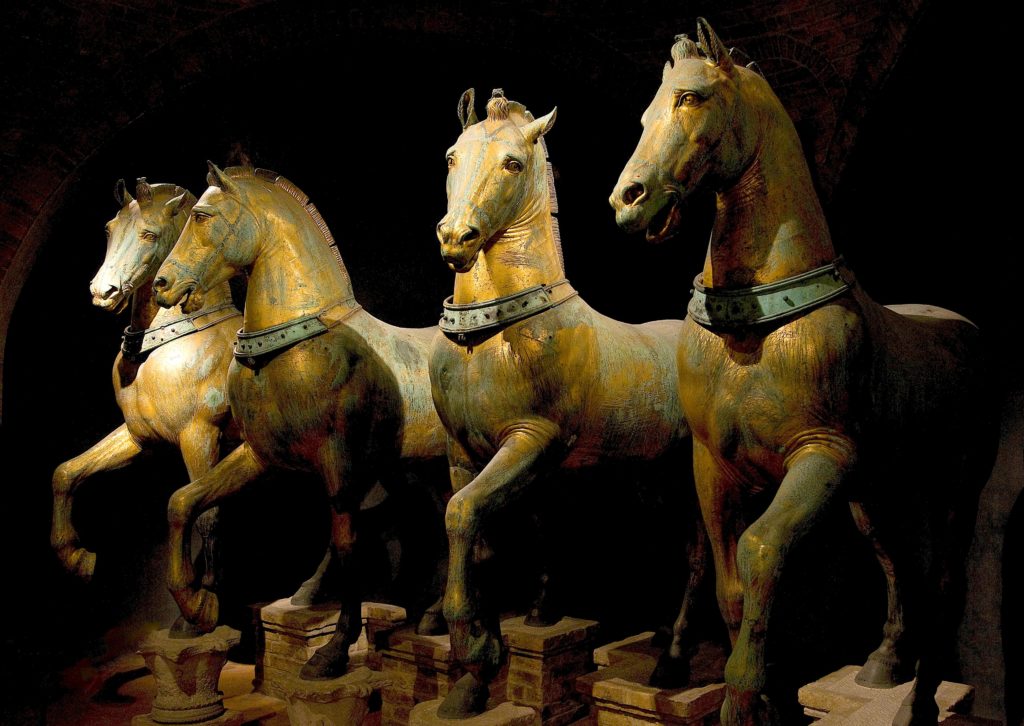
If the horse is in conformity with the typology of the magnificent horses composing the quadriga overseeing the Basilica of Saint Mark of Venice (Greek statuary of the IVth century BC brought back by the crusaders from Constantinople to Venice in 1204) and of the horse of Marcus Aurelius, its musculature is more nervously underlined and traced. Objectively, this statue is ideally more proportionate. There is also more fine detail, a result of new pre-sculpture techniques, making the work captivating and realistic to look at.

The sculpture overflows its pedestal. According to André Suarès quoted in The Majesty of Centaurs:
Colleone on horseback walks in the air, he will not fall. He cannot fall. He leads his earth with him. His base follows him […] He has all the strength and all the calm. Marcus Aurelius, in Rome, is too peaceful. He does not speak and does not command. Colleone is the order of the force, on horseback. The force is right, the man is accomplished. He goes a magnificent amble. His strong beast, with the fine head, is a battle horse; he does not run, but neither slow nor hasty, this nervous step ignores the fatigue. The condottiere is one with the glorious animal: he is the hero in arms.

His baton of command is even metamorphosed into a bludgeon! But since it is not Verrocchio who finished this work, let us not blame the latter for the warlike fury that emanates from this statue.
Venice, a vicious slave-trading financial and maritime Empire fronting as a “Republic”, clearly took its revenge here on the beautiful conception developed during the Renaissance of a philosopher-king defending the nation-state.
On the aesthetic level, this mercenary smells like an animal. As a good observer, Leonardo warned us: when an artist represents a man entirely imprisoned by a single emotion (joy, rage, sadness, etc.), he ends up painting something that takes us away from the truly human soul. This is what we see in this equestrian statue.
If, on the contrary, the artist shows several emotions running through the figure represented, the human aspect will be emphasized. This is the case, as we have seen, with Donatello’s Gattamelata, uniting cunning, determination and prudence to overcome fear the face of threat.
Leonardo’s own, gigantic project to erect a gigantic bronze horse, on which he worked for years and developed new bronze casting techniques, unfortunately was never build, seen the hectic circumstances.

Finally, beyond all the interpretations, let us admire the admirable know-how of these artists. In terms of craft and skill, it generally took an entire life to become able to realize such great works, not even mentioning the patience and boundless passion required.
Up to us to bring it back to life !
Bibliography:
- Verrocchio, Sculptor and Painter of Renaissance Florence, Andrew Butterfield, National Gallery, Princeton University Press, 2020;
- Donatello, John Pope-Hennessy, Abbeville Press, 1993;
- Uccello, Franco and Stefano Borsi, Hazan, 2004;
- Les Commentaires de Lorenzo Ghiberti dans la culture florentine du Quattrocento, Pascal Dubourg-Glatigny, Histoire de l’Art, N° 23, 1993, Varia, pp. 15-26;
- Monumento Equestre al Gattamelata di Donatello: la Statua del Guerriero Astuto, blog de Dario Mastromattei, mars 2020;
- La sculpture florentine de la Renaissance, Charles Avery, Livre de poche, 1996 ;
- La sculpture de la Renaissance au XXe siècle, Taschen, 1999;
- Ateliers de la Renaissance, Zodiaque-Desclée de Brouwer, 1998;
- Rabelais et l’art de la guerre, Christine Bierre, 2007.
- The Greek language project, Plato and the Renaissance, Karel Vereycken, jan. 2021.
Hugo van der Goes et la Dévotion moderne


Le beau livre de l’historien néerlandais Bernhard Ridderbos, Schilderkunst in de Bourgondische Nederlanden (La peinture aux Pays-Bas bourguignon, Davidsfonds, Leuven 2015) est un régal pour les yeux et l’esprit.
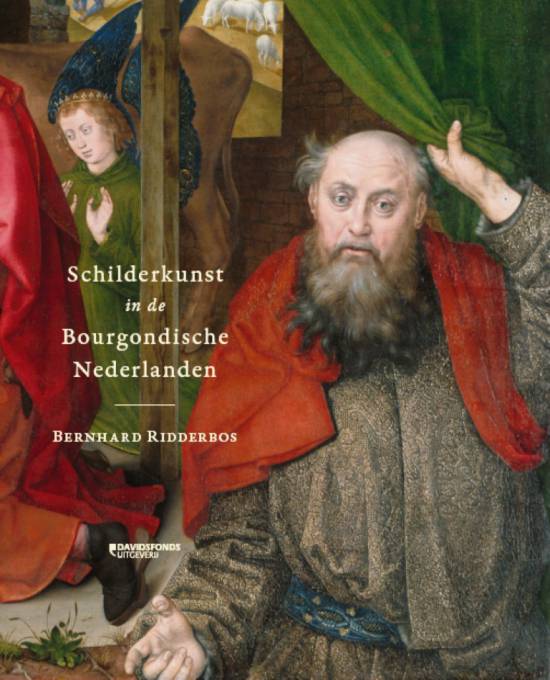
Ridderbos, déjà irrité par l’habile campagne de propagande menée depuis des siècles par des banquiers italiens pour qui « la » Renaissance n’était qu’italienne et pour qui les fiammingo n’étaient que des « Primitifs », démarre son ouvrage en incendiant (non sans raison) une œuvre qui reste une référence, L’automne du Moyen Age (1919), de Johan Huizinga (1872-1945).
Pour cet historien néerlandais influant, recteur de l’Université de Leyden :
L’art de Van Eyck, dans sa capacité de figurer les choses saintes, a su atteindre un haut degré de détail et de naturalisme, marquant sans doute un point de départ sur le plan strict de l’histoire de l’art, mais signifiant en réalité une fin sur le plan historico-culturel. La tension extrême de l’imagination terrestre du divin fut atteint ici ; cependant, le contenu mystique de son imagination s’apprêtait à quitter ces images et à ne laisser les réjouissances qu’à la forme
Niant l’esprit clairement pré-renaissant des peintres flamands du début du XVe siècle, pour Huizinga, leur naturalisme n’était rien d’autre que « le déploiement ultime de l’esprit moyenâgeux tardif. »
Or, comme j’ai cherché à démontrer, en avril 2006, lors de mon exposé au Colloque international à la Sorbonne sur le thème de « La recherche du divin à travers l’espace géométrique », Robert Campin, Jan van Eyck et d’autres peintres flamands, qu’on présente assez souvent comme récalcitrant à utiliser les modèles perspectivistes développés par l’italien Leon Battista Alberti et comme en témoigne la présence assez imposante de miroirs convexes dans leurs œuvres (Volets Werl, Epoux Arnolfini), se sont inspirés des travaux mathématiques et géométriques complexes du grand scientifique arabe Ibn Al-Haytam.
Mieux connu en Occident sous son nom latin Alhazen, ses travaux d’optique, notamment sur la lumière et les miroirs convexes, se retrouvent dans les carnets de Léonard de Vinci, lecteur assidu des Commentaires de Ghiberti. *
Libéré de cette chape de plomb de l’autocensure, Ridderbos approfondit l’iconographie, les contextes économiques, sociaux et culturels. Sans égarer le lecteur dans un marécage de détails et d’hypothèses stériles, il nous offre des éclairages très intéressants sur le comment et le pourquoi des créations artistiques de cette époque.
Ceux parmi vous qui n’ont jamais pris le temps de lire ni l’œuvre monumentale d’Erwin Panofsky, ni les imposantes monographies publiées en Belgique par le Fonds Mercator d’Anvers relatant in extenso la vie des grands peintres flamands tels que Robert Campin, Rogier Van der Weyden, Jan Van Eyck, Hans Memling, Thierry Bouts, Hugo Van der Goes et Gérard David, remercieront Ridderbos pour non seulement en avoir extrait la quintessence, mais pour les avoir mis en relation les unes avec les autres.
Les commanditaires
En premier lieu, il montre à quel point les artistes étaient soumis à des « carnets de charges » très stricts. Un tel monastère, une telle guilde, un tel seigneur passait commande. Ils fixaient la taille de l’œuvre, le sujet et les personnes à représenter. Plusieurs théologiens, spécialistes du thème à traiter, furent parfois nommés pour conseiller et accompagner le peintre dans sa représentation de sujets religieux. L’artiste exécuta d’abord, sur son panneau, un dessin. Et ce n’est qu’une fois validé par le commanditaire, souvent après de nombreuses modifications, qu’il appliqua les couleurs. Gérard David, par exemple, a du changer l’ensemble des portraits des échevins sur son œuvre, suite à l’élection d’une nouvelle équipe…
Rivalités
Ensuite, Ridderbos indique comment les rivalités des uns et des autres, princes, églises, mais aussi Cités-Etats, souvent en quête de prestige (le fameux « soft power » de nos jours), ont profité à la vie artistique flamande. Princes, ducs, rois et banquiers étrangers se disputaient les peintres flamands pour fanfaronner et se mettre en avant.

Pour monter en grade, un banquier des Médicis (Angelo Tani) commande un triptyque à Hans Memling, un Jugement dernier (1466-1473), largement inspiré de l’œuvre éponyme de Van Der Weyden pour l’Hospice de Beaune.
Lorsque son confrère (Tommaso Portinari, le fondé de pouvoir des Médicis à Bruges) l’apprend, il passe commande d’un autre triptyque, une Nativité (1475), bien plus grand et plus splendide encore chez Hugo Van der Goes. Ce « triptyque Portinari » sera dévoilé à Florence en 1483 et inspirera toute une série d’œuvres italiens, notamment celles du peintre italien Domenico Ghirlandaio.
Rogier Van der Weyden, après avoir travaillé pour la ville de Louvain, se voit offrir un bien meilleur salaire par la ville de Bruxelles, les deux villes cherchant à devenir la capitale de la région.
Lorsqu’il y peint pour l’Hôtel de Ville un grand retable sur la Justice (La Justice de Trajan et Herkenbald, ca. 1450), la ville de Louvain, pour ne pas être en reste, commandera plusieurs années après une œuvre semblable (La justice d’Otton III, 1473) à Thierry Bouts, provoquant à son tour une autre ville, celle de Bruges d’en commander un du même type (Le jugement de Cambyses, 1498) chez Gérard David, un disciple et proche de l’atelier de Van der Goes.
Ridderbos bien sûr ne se limite pas à tracer cette dynamique sociologique. Il analyse comment ces peintres vont dialoguer entre eux en reprenant à leur compte les apports techniques et iconographiques de leurs confrères. Tout en mobilisant le meilleur d’eux-mêmes, ils apportèrent des choses entièrement nouvelles. C’est un processus assez similaire à l’apport compositionnel d’un Ludwig van Beethoven montant lui-même « sur les épaules des géants » que furent avant lui Bach, Haydn et Mozart.
Van der Goes et la Dévotion moderne
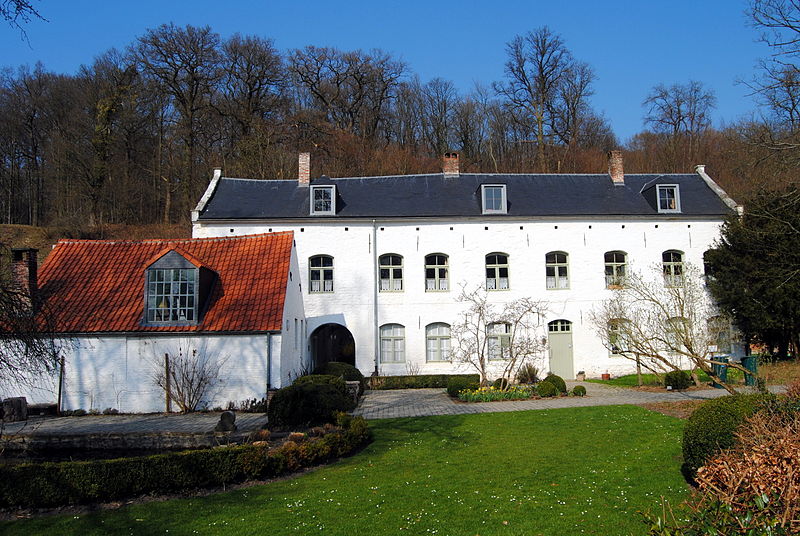
Dans le chapitre VII, page 179, l’auteur fait un effort particulier pour mettre en valeur l’œuvre d’Hugo Van Der Goes, un peintre remarquable qu’on a rangé un peu vite dans l’ombre de Van Eyck, Van der Weyden et Memling.
Probablement né vers 1440 à Gand, Van der Goes est reçu maître de la guilde des peintres de cette ville en 1467 et en devient le doyen en 1474. Trois ans plus tard, il est à l’apogée de la reconnaissance professionnelle et de la réussite sociale.
C’est alors qu’il abandonne la vie bourgeoise pour s’associer au grand mouvement de réforme appelé la Dévotion moderne. Pour ce faire, Van Der Goes devient frère lai auprès des Soeurs et Frères de la Vie commune, plus précisément ceux de l’abbaye du Rouge-Cloître (Rooklooster) dans la Forêt de Soignes près de Bruxelles. Il y jouit de certains privilèges, comme d’être autorisé à continuer à peindre.
Deventer
La Dévotion moderne sera avant tout un mouvement éducateur. Elle fonda notamment à Deventer une école renommée ouverte aux pauvres et aux orphelins. Rudolf Agricola et son successeur Alexandre Hegius y enseignent le grec et le latin à toute une génération d’humanistes dont le plus connu s’appelle Erasme de Rotterdam.
Le fameux cardinal-philosophe, mathématicien et juriste allemand, Nicolas de Cues (1401-1464) tenait en haute estime les efforts des enseignants de Deventer. En 1469, cinq ans après sa mort, sans doute en accord avec ses derniers vœux, une partie de son héritage ira abonder (de 1470 à 1682) un fond dédié, la Bursa Cusana, permettant à une vingtaine d’élèves, dont la moitié originaire de la ville natale de Cues, d’y parfaire leur instruction.
Le piétisme de la Devotion moderne, centré sur l’intériorité, s’articule le mieux dans le petit livre de Thomas van Kempen (a Kempis) (1380-1471), L’imitation de Jésus Christ. Celui-ci souligne l’exemple à suivre de la passion du Christ tel que nous l’enseigne l’Évangile, message repris par Erasme.
Van Der Goes, animé à titre personnel par l’esprit de cette démarche, apparaît ainsi, sans l’avoir connu, avec le peintre anversois Quinten Matsys, comme « le plus erasmien » des peintres flamands. Et à ce titre, il sera capable de faire transparaître dans ses œuvres une tension dramatique plus aiguë, traduite par l’animation et l’expressivité des personnages.
Les bergers
On pense immédiatement aux magnifiques bergers du Triptyque Portinari. Cette œuvre est commanditée par un des banquiers les plus riches de l’époque et pourtant, ce ne sont pas les trois Rois mages qui se trouvent au premier plan, mais d’humbles bergers arrivés bien avant eux et les premiers à reconnaître l’enfant pour ce qu’il est.
Se démarquant nettement de la façon dont le peintre italien Andrea Mantegna les avait dépeint vingt ans plus tôt, c’est-à-dire comme des pauvres hères en haillons, hirsutes, sales et édentés, Van der Goes souligne leur dignité et met en avant leurs transformations.
D’ailleurs, les expressions des bergers incarneraient les trois étapes spirituelles définies par un autre inspirateur de la Devotion moderne, le mystique flamand Jan Van Ruysbroeck (1293-1381) : la vie active, la vie intérieure et la vie contemplative où l’Homme entre en communion spirituelle avec Dieu. **
Le chapeau de Nicodème

Autre exemple, son tableau La lamentation du Christ (après 1479) actuellement au Musée de Vienne. De prime abord rien de bien révolutionnaire dans cette représentation. On y voit la mère du Christ retenue par Jean lorsqu’elle s’effondre sur la dépouille mortelle de son fils.
C’est sur l’avant plan que deux figures méritent notre attention. S’appuyant sur les Geestelijke Opklimmingen (Des ascensions spirituelles) écrit par Gerard Zerbold de Zutphen (1367-1398), un auteur de la Dévotion moderne proche de Groote, Ridderbos identifie leur rôle dans cette œuvre.
A droite, d’abord, on voit Nicodème coiffé d’une capuche rouge. Selon l’Evangile selon Saint-Jean, Nicodème a été un des premiers pharisiens devenus secrètement disciples de Jésus. Ici, on le voit en pleine crise, pour ne pas dire agonie existentielle, portant un regard effrayé sur son riche chapeau posé par terre.
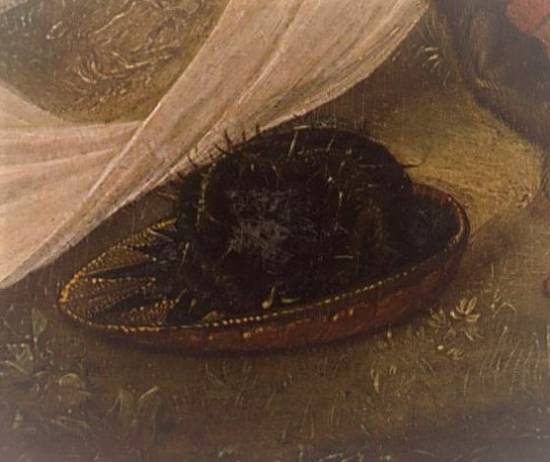
Or, lorsque l’on examine de plus près ce couvre-chef, on découvre qu’il est surmonté d’une couronne d’épines !
La métaphore est donc à l’image de la Dévotion moderne qui exigeait de chacun, non seulement de suivre fidèlement les rites, mais de « vivre à l’imitation du Christ », c’est-à-dire de s’élever à un tel niveau d’amour pour le Christ et l’humanité qu’on puisse offrir librement ses possessions, son patrimoine et même sa vie au vrai, au juste et au beau.
Enfin, pour compléter le tableau, à gauche, toujours au premier plan, la figure de Marie Madeleine, une autre disciple de Jésus qui le suit jusqu’à ses derniers jours.
Prostituée repentie, Marie Madeleine complète à merveille la métaphore en s’érigeant ici comme l’exemple même du travail d’introspection et d’auto-perfectionnement personnel qu’exigeaient les Sœurs et Frères de la Vie Commune.
Le message est fort : vous ne pouvez pas vous contenter d’adorer ou d’admirer le Christ ! Vous devez changer vos vies ! Un message qui n’a pas perdu de son actualité…


Notes:
* Ibn Al-Haytam (Alhazen) (965-1039) écrivit quelques 200 ouvrages sur les mathématiques, l’astronomie, la physique, la médecine et la philosophie. Né à Bassora, et après avoir travaillé sur l’aménagement des cours du Nil en Égypte, il se serait rendu en Espagne. Il aurait mené une série d’expériences très précises sur l’optique théorique et expérimentale, y compris sur la camera obscura (chambre noire), travaux qu’on retrouve ultérieurement dans les études de Léonard de Vinci. Ce dernier a pu lire les longs passages d’Alhazen qui figurent dans les Commentari du sculpteur florentin Ghiberti. Après que l’évêque de Reims Gerbert d’Aurillac (le futur pape Sylvestre II en 999) ramena d’Espagne le système décimal avec son zéro et un astrolabe, c’est grâce à Gérard de Crémone (1114-vers 1187) que l’Europe va accéder à la science grecque, juive et arabe. Ce savant se rendra 1175 à Tolède pour y apprendre l’arabe et effectuera la traduction de quelques 80 ouvrages scientifiques de l’arabe en latin, notamment l’Almageste de Ptolémée, les Coniques d’Apollonius, plusieurs traités d’Aristote, le Canon d’Avicenne, les œuvres d’Ibn Al-Haytam, d’Al-Kindi, de Thabit ibn Qurra et d’Al-Razi. Dans le monde arabe, ces recherches furent reprises un siècle plus tard par le physicien persan Al-Farisi (1267-1319). Ce dernier a rédigé un important commentaire du Traité d’optique d’Alhazen. En prenant pour modèle une goutte d’eau et en s’appuyant sur la théorie d’Alhazen sur la double réfraction dans une sphère, il a donné la première explication correcte de l’arc-en-ciel. Il a même suggéré la propriété ondulatoire de la lumière, alors qu’Alhazen avait étudié la lumière à l’aide de balles solides dans ses expériences de réflexion et de réfraction. Désormais la question se posait ainsi : la lumière se propage-t-elle par ondulation ou par transport de particules ?
** Voir à ce propos : Nadeije Laneyrie-dagen, L’invention du corps : La représentation de l’homme du Moyen Âge à la fin du XIXe siècle, Paris 1997, 52. ; Delphine Rabier, Les trois degrés de la vision selon Ruysbroeck l’Admirable et les Bergers du triptyque Portinari de Hugo van der Goes, in Studies in Spirituality, 27, p. 163-179, 2017.












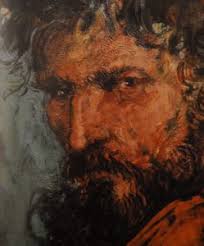



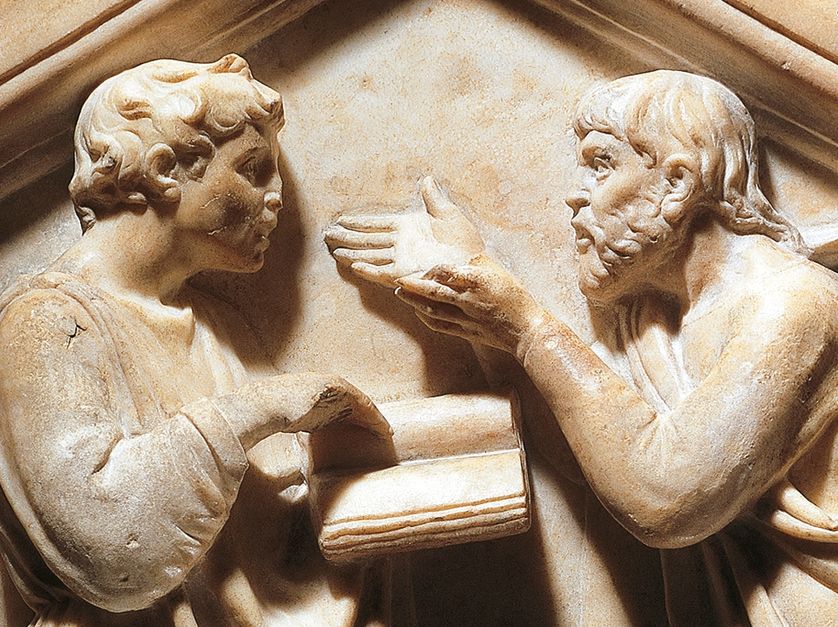

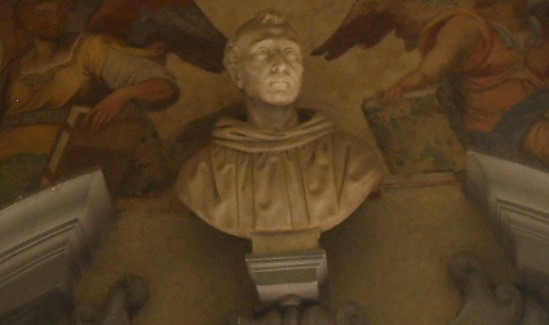



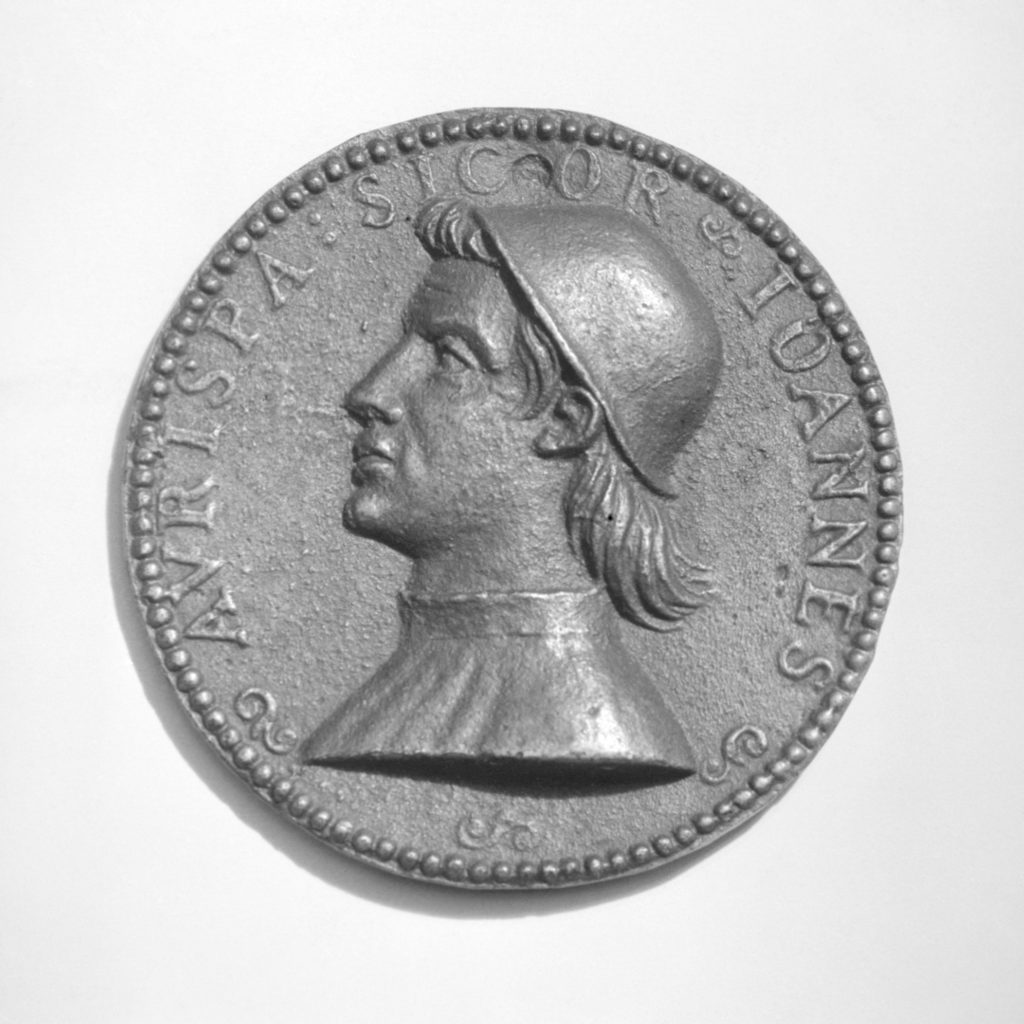
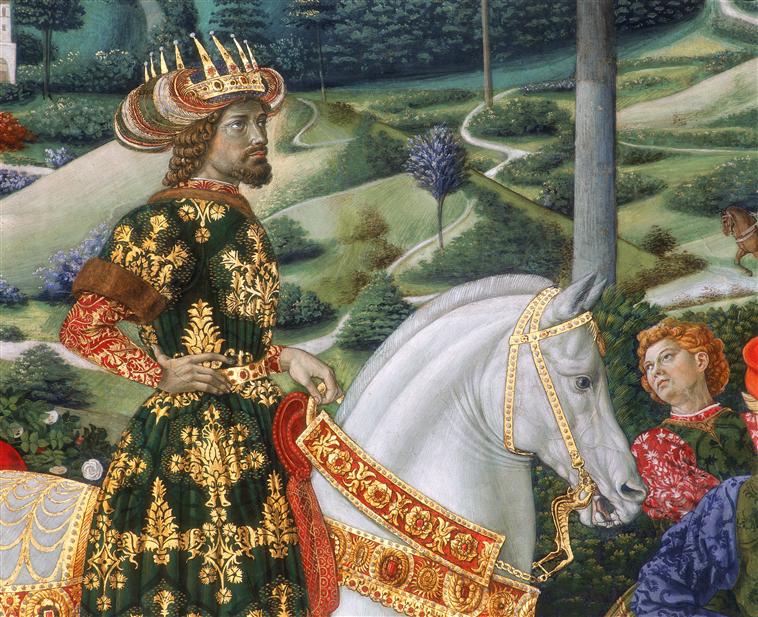


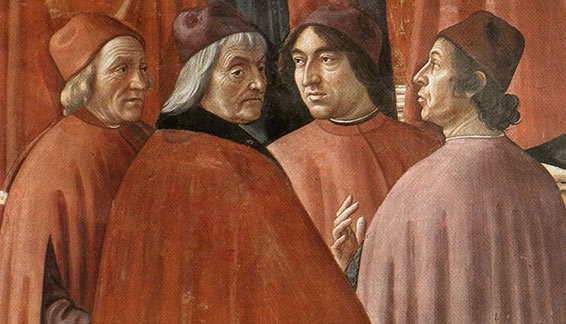
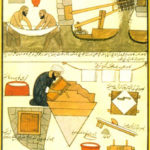
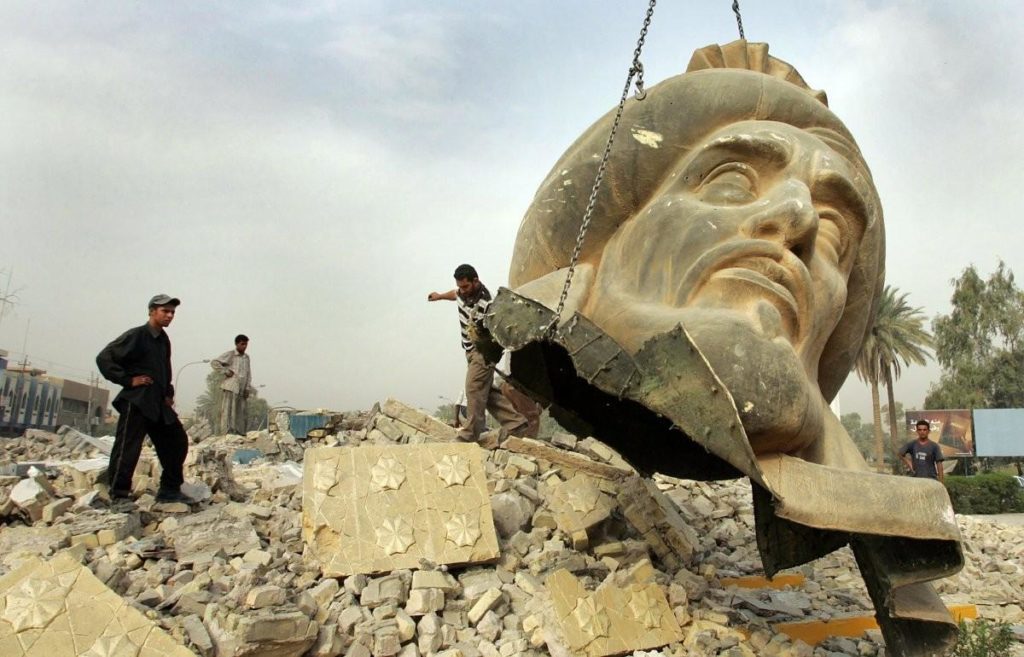




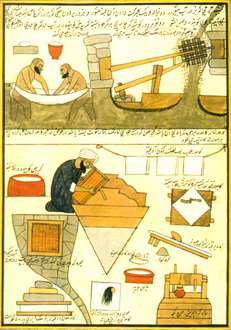

Posted by: Karel Vereycken | on avril 10, 2022
Avicenne et Ghiberti, leur rôle dans l’invention de la perspective à la Renaissance
This article, in EN
Tout visiteur du centre historique de Florence pose fatalement, à un moment donné, son regard sur les portes richement décorées du Baptistère, cet édifice roman faisant face à la cathédrale Santa Maria del Fiore, coiffée par Filippo Brunelleschi de sa magnifique coupole.
Dans cet article, Karel Vereycken apporte un éclairage nouveau sur les apports arabes à la science et le rôle crucial de Lorenzo Ghiberti dans l’invention de la perspective à la Renaissance.
Le Baptistère, que la plupart des Florentins pensaient être construit sur l’emplacement d’un temple romain dédié à Mars, le dieu tutélaire de l’ancienne Florence, est l’un des plus anciens bâtiments de la ville, construit entre 1059 et 1128 dans le style roman local.
Le poète italien Dante Alighieri et de nombreuses autres personnalités de la Renaissance, dont des membres de la famille Médicis, y furent baptisés.
A la Renaissance, à Florence, les corporations et les guildes se disputaient le premier rôle à coup de réalisations artistiques toutes aussi prestigieuses les unes que les autres.
Alors que l’Arte dei Lana (Corporation des producteurs de laine) finançait les Œuvres (Opera) du Duomo et donc la construction de sa coupole géante, l’Arte dei Mercatanti o di Calimala (Guilde des marchands d’étoffes étrangères) s’occupait du Baptistère et finançait l’embellissement des portes.
Les portes du Paradis
Le bâtiment octogonal possède quatre entrées, dont trois ont acquis une renommée artistique mondiale avec des portes ornées de bas-reliefs en bronze, recouverts entièrement ou en partie d’une fine couche d’or. Trois dates marquent les travaux : 1339, 1401 et 1424.
détail : baptême de Jésus (à gauche) et de ses disciples (à droite).
Avec l’aide de son père, il va réaliser son ouvrage en utilisant une technique connue sous le nom de « fonte à la cire perdue », technique qu’il a dû entièrement réinventer car perdue depuis la chute de l’Empire romain. L’une des raisons pour lesquelles Ghiberti a remporté le concours est le simple fait que sa technique était si avancée qu’elle nécessitait 20 % de métal en moins (7 kg par panneau) que celle de ses concurrents, le bronze étant un matériau onéreux, bien plus coûteux que le marbre. Sa technique, appliquée à l’ensemble de la décoration de la porte Nord, par rapport à celle de son concurrent, aurait permis d’économiser environ 100 kg de bronze. Or, en 1401, avec la peste qui harcelait régulièrement Florence, les conditions économiques étaient déclinantes, ce qui fait que la riche Calimala surveillait de près le coût du programme.
Pendant de l’œuvre de son prédécesseur, les bronzes de la porte nord comprennent eux aussi 28 panneaux, dont 20 représentent la vie du Christ d’après le Nouveau Testament. Les 8 panneaux inférieurs représentent les quatre évangélistes et les Pères de l’Église, saint Ambroise, saint Jérôme, saint Grégoire et saint Augustin.
Selon les Vies des artistes de Giorgio Vasari (1511-1574), Michelangelo Buonarroti (1475-1564) les jugera plus tard « si belles qu’elles orneraient l’entrée du Paradis ».
(commencées en 1424, terminées en 1452).
Dessin, sculpture, anatomie, perspective, travail des métaux, architecture, etc., en deux générations, le grand chantier des Portes permit à une myriade d’assistants et d’élèves bien payés d’accéder à une formation hors pair.
Parmi eux, plusieurs artistes exceptionnels tels que Luca della Robbia, Donatello, Michelozzo, Benozzo Gozzoli, Bernardo Cennini, Paolo Uccello, Andrea del Verrocchio et les fils de Ghiberti, Vittore et Tommaso. Au fil du temps, ces portes de bronze pesant trois tonnes et hautes de 5,06 mètres sont devenues une icône de la Renaissance, l’une des œuvres d’art les plus célèbres au monde.
En 1880, le sculpteur français Auguste Rodin s’en inspira pour ses propres Portes de l’Enfer, sur lesquelles il travailla pendant 38 ans.
La révolution
Le changement radical de conception de la sculpture en bronze, intervenu entre la Porte du nord et la Porte orientale, est essentiel pour notre discussion ici, car il reflète la façon dont l’artiste et ses mécènes ont voulu partager avec le public leurs nouvelles idées, inventions et découvertes.
Les thèmes du portail nord de 1401 s’inspiraient de scènes du Nouveau Testament, excluant de facto le panneau réalisé par Ghiberti, Le Sacrifice d’Isaac, qui lui avait valu de remporter le concours la même année. Pour compléter l’ensemble, il était donc tout à fait logique que la porte orientale de 1424 reprenne les thèmes de l’Ancien Testament.
A l’origine, c’est l’érudit et ancien chancelier de Florence Leonardo Bruni (1369-1444) qui avait programmé une iconographie assez semblable aux deux portes précédentes. Après des discussions animées, sa proposition fut écartée pour quelque chose de radicalement nouveau. En effet, au lieu de prévoir 28 panneaux, on décida, pour des raisons esthétiques, d’en réduire le nombre à seulement 10 reliefs carrés beaucoup plus grands, entre des bordures contenant des statuettes dans des niches et des médaillons avec des bustes.
Ainsi, chacun des 10 chapitres de l’Ancien Testament contient, pour ainsi dire, plusieurs événements, de sorte que le nombre net de scènes est passé de 20 à 37, et en plus, toutes apparaissent en perspective :
Le thème général est celui du salut à partir de la tradition patristique latine et grecque. Après les trois premiers panneaux, centrés sur le thème du péché, Ghiberti commence à mettre plus clairement en évidence le rôle du Dieu sauveur et la préfiguration de la venue du Christ. Les panneaux ultérieurs sont plus faciles à comprendre. C’est le cas du panneau Isaac, Jacob et Esaü, où les personnages se fondent dans une perspective de telle sorte que l’œil est guidé vers la scène principale.
La plupart des sources de ces scènes étant écrites en grec ancien, dont la maîtrise n’était pas si courante à l’époque, on pense que Ghiberti aurait eu pour conseiller théologique Ambrogio Traversari (1386-1439), avec qui il était en constante relation. Traversari était un proche de Nicolas de Cues (1401-1464), protecteur de Piero della Francesca (1412-1492) et organisateur actif du Conseil œcuménique de Florence de 1438-39, qui tenta de mettre fin au schisme séparant les Églises d’Orient et d’Occident.
Perspective
Les reliefs en bronze, connus pour leur vive illusion d’espace, sont l’un des événements révolutionnaires qui incarnent la Renaissance. On y voit de façon spectaculaire des figures passer d’une surface plane à toute la plénitude d’une existence en trois dimensions ! Techniquement parlant, on passe du stiacciato (développé à la perfection par Donatello)* à la ronde bosse, en passant par le bas-relief et le haut relief. Ghiberti avait bien conscience de son exploit, comme en témoigne son autoportrait sur la porte, la tête sortant d’une médaille de bronze, regardant avec satisfaction les spectateurs admirant son œuvre. L’artiste souhaitait bien plus qu’une perspective, il cherchait un espace de respiration !
Cette approche nouvelle influencera Léonard de Vinci (1452-1517). Comme le souligne l’historien d’art Daniel Arasse :
Au début du XVe siècle, plusieurs approches théoriques s’opposent. Vers 1423-1427, Donatello, un jeune collaborateur de Ghiberti réalisa son Festin d’Hérode, un bas relief selon la technique du stiacciato réalisé pour les fonts baptismaux du baptistère de Sienne.
Dans cette œuvre, le sculpteur déploie une perspective harmonieuse à point de fuite centrale. Vers la même époque, le peintre Massacchio (1401-1428) a utilisé une construction semblable dans sa fresque La Trinité.
Comme nous allons le voir, Ghiberti, partant de l’anatomie de l’œil, s’oppose aussi bien dans ses œuvres que dans ses écrits à cette approche abstraite et travaille, dès 1401, sur d’autres modèles géométriques, dites binoculaires. (voir plus bas).
Jésus parmi les docteurs, Ghiberti, avant 1424.
Jésus parmi les docteurs, Ghiberti, avant 1424.
Vers 1407, Brunelleschi a lui aussi mené plusieurs expériences sur cette question, très probablement sur la base d’idées développées par un autre ami de Nicolas de Cues, l’astronome italien Paolo dal Pozzo Toscanelli (1397-1482), dans son traité Della prospettiva, aujourd’hui perdu. Ce que l’on sait, c’est que Brunelleschi cherchait avant tout à démontrer que toute perspective n’est qu’illusion optique.
En 1435, l’architecte humaniste Leon Baptista Alberti (1406-1472), dans son traité Della Pictura, tentera, sur la base de l’approche de Donatello, de théoriser la représentation d’un espace tridimensionnel harmonieux et unifié sur une surface plane.
Malheureusement, au désespoir de bien des artistes, le traité d’Alberti, entièrement théorique, ne contient aucun diagramme ni illustration…
Sept ans plus tôt, le peintre Massacchio (1401-1428) avait utilisé, du moins en partie, une construction semblable dans sa fresque La Trinité.
Enfin, Léonard, qui avait lu et étudié les écrits de Ghiberti, utilisa ses arguments pour souligner les limites et même démontrer le dysfonctionnement de la construction de la perspective « parfaite » d’Alberti, surtout lorsqu’elle dépasse le cadre d’un angle de 30 degrés.
Dans le Codex Madrid, II, 15 v. de Vinci se rend à l’évidence qu’« en soi, la perspective offerte par une paroi rectiligne est fausse à moins d’être corrigée (…) »
Perspectiva artificialis versus perspectiva naturalis
La perspectiva articifialis d’Alberti n’est autre qu’une abstraction qui se veut nécessaire et utile pour représenter une organisation rationnelle de l’espace. Sans cette abstraction, nous dit-on, il est quasiment impossible de définir avec une précision mathématique les relations entre l’apparition des objets et le recul de leurs différentes proportions sur un écran plat : largeur, hauteur et profondeur.
A partir du moment où une image donnée sur un écran plat a été pensée comme la coupe transversale d’un cône ou d’une pyramide, une méthode a émergé pour ce qui est considéré, à tort, comme une représentation objective de l’espace tridimensionnel réel, alors qu’il ne s’agit que d’une anamorphose, c’est-à-dire un trompe-l’œil ou une illusion optique.
Ce qui est fâcheux, c’est que cette construction fait totalement abstraction de la réalité physique de notre appareil perceptif, en prétendant :
Calomnies et ragots
Pour des raisons qui restent à élucider, le rôle crucial de Ghiberti a été soit ignoré soit minimisé. Par exemple, les Commentarii, un manuscrit en trois volumes où Ghiberti retrace sa vie, son approche artistique et ses recherches sur l’optique et la perspective, n’a jamais été traduit en anglais ni en français. Et l’édition italienne ne date que de 1998.
Au XVIe siècle, Giorgio Vasari, qui fit souvent office d’agent de relations publiques pour le clan des Médicis, et dont l’ouvrage Les Vies des artistes est devenu l’alpha et l’oméga des historiens d’art, signale avec condescendance, mais sans évoquer une once de son contenu, que Ghiberti a écrit « un ouvrage en langue vernaculaire dans lequel il a traité de nombreux sujets différents, mais les a disposés de telle manière que l’on ne peut guère tirer profit de sa lecture ».
Qu’il ait pu exister des tensions entre humanistes, certes. Après tout, ces artisans autodidactes, tels que Ghiberti passionnés de progrès techniques, d’une part, et les héritiers de riches marchands de laine, tel le bibliophile Niccoli d’autre part, venaient de mondes totalement différents. D’après une anecdote racontée par Guarino Veronese, en 1413, Niccoli rencontre un jour Filippo et le salue de manière hautaine en ces termes : « Ô philosophe sans livres », à quoi Filippo lui aurait répliqué en souriant : « Ô livres sans philosophe… »
A cela s’ajoute que comme le stipulait le contrat, Ghiberti a accordé l’œuvre commandée en 1401 avec l’œuvre de Pisano d’inspiration gothique. Du coup, certains en déduisent que Ghiberti n’appartenait pas réellement à la Renaissance. Pour preuve, selon ses détracteurs, « son souci du détail et ses figures aux lignes ondulées et élégantes, ainsi que la variété des plantes et des animaux représentés… »
Les humanistes
symbolisée ici par la rencontre entre ces deux personnages royaux.
On pense que cette scène a été créée à la demande d’Ambrogio Traversari, présent dans la foule et instigateur du Conseil œcuménique de Florence de 1438.
Certes, les Commentarii ne sont pas rédigés selon les règles rhétoriques de l’époque. Écrits à la fin de sa vie, ils pourraient même avoir été dictés par l’artiste vieillissant à un clerc mal formé, faisant quantité de fautes d’orthographe.
Cependant, les propos de Ghiberti révèlent un auteur instruit, ayant une connaissance approfondie de nombreux penseurs classiques grecs et arabes. Il n’était pas seulement un brillant artisan, mais bien un « homme de la Renaissance » typique. En dialogue permanent avec Bruni, Traversari et le « chasseur de manuscrits » Niccolo Niccoli, Ghiberti, qui ne savait pas lire le grec mais connaissait bien le latin, était manifestement au courant de cette redécouverte de la science grecque et arabe.
Cette ambition était portée par les membres du Cercle San Spirito fondé par Boccace et Salutati, et dont les invités (parmi lesquels Bruni, Traversari, Cues, Niccoli, Côme de Médicis, etc.) se réuniront par la suite au couvent Santa Maria degli Angeli.
Ghiberti échange d’ailleurs avec Giovanni Aurispa, ce collaborateur de Traversari qui ramena, avant Bessarion, l’ensemble des oeuvres de Platon en Occident.
Amy R. Bloch, dans son étude très documentée Lorenzo Ghiberti’s Gates of Paradise, Humanism, History, and Artistic Philosophy in the Italian Renaissance (2016), note que « Traversari et Niccoli peuvent être liés directement aux origines du projet des Portes et étaient clairement intéressés par les commandes de sculptures prévues pour le Baptistère « .
« Le 21 juin 1424, après que la Calima ait demandé à Bruni son programme pour les portes, Traversari écrit à Niccoli en reconnaissant, en termes seulement généraux, les idées de Niccoli pour les histoires à inclure et en mentionnant, sans désapprobation évidente, que la guilde s’était plutôt tournée vers Bruni pour obtenir des conseils.«
Palla Strozzi
Ghiberti se lie également d’amitié avec Palla Strozzi (1372-1462), qui, en plus d’être l’homme le plus riche de Florence avec une fortune imposable de 162 925 florins en 1427, comprenant 54 fermes, 30 maisons, une entreprise bancaire au capital de 45 000 florins et des obligations communales, était aussi un homme politique, un écrivain, un philosophe et un philologue.
Tout comme Ambrogio Traversari, Paolo Rossi et Leonardo Bruni, Palla Strozzi a étudié le grec sous la direction de l’érudit byzantin Manuel Chrysoloras, invité à Florence par Salutati pour y enseigner le grec. A noter, le fait que Strozzi prit à sa charge une partie du traitement de Chrysoloras et fit venir de Constantinople et de Grèce les livres nécessaires à l’enseignement nouveau. La relation étroite de Ghiberti avec Palla Strozzi, écrit Bloch, « lui donnait accès à ses manuscrits et, ce qui est tout aussi important, à la connaissance qu’en avait Strozzi. «
Ce n’était pas tout, car « la relation entre Ghiberti et Palla Strozzi était si étroite que, lorsque Palla se rendit à Venise en 1424 comme l’un des deux ambassadeurs florentins chargés de négocier une alliance avec les Vénitiens, Ghiberti l’accompagna dans sa suite. »
Strozzi était connu comme un véritable humaniste, cherchant toujours à préserver la paix tout en s’opposant fermement au pouvoir oligarchique, tant à Florence qu’à Venise.
En fait, c’est Palla Strozzi, et non Cosimo de’ Medici, qui a été le premier à lancer les plans de la première bibliothèque publique de Florence, et il avait l’intention de faire de la sacristie de Santa Trinita son entrée. Si la bibliothèque de Palla n’a jamais été réalisée en raison du conflit politique dramatique connu sous le nom de Coup des Albizzi qui a conduit Strozzi à son exil en 1434, Cosimo, qui a eu les coudées franches pour régner sur Florence, fera sien le projet de bibliothèque.
Un constat audacieux
Tout d’abord, Lorenzo Ghiberti fait un constat audacieux, pour un chrétien dans un monde chrétien, sur la façon dont l’art de l’Antiquité a été perdu :
Ghiberti comprenait l’importance de la multidisciplinarité pour la formation de l’artiste.
Selon lui, « la sculpture et la peinture sont des sciences de plusieurs disciplines nourries par des enseignements différents ».
Dans le livre I de ses Commentarii, Ghiberti donne une liste des 10 arts libéraux que le sculpteur et le peintre doivent maîtriser : philosophie, histoire, grammaire, arithmétique, astronomie, géométrie, perspective, théorie du dessin, anatomie et médecine et souligne la nécessité pour un artiste d’assister aux dissections anatomiques.
Comme le souligne Amy Bloch, alors qu’il travaillait sur les Portes, dans le processus intense de visualisation des histoires de la formation du monde par Dieu et de ses habitants vivants, l’engagement de Ghiberti « a stimulé en lui un intérêt pour l’exploration de tous les types de créativité – non seulement celle de Dieu, mais aussi celle de la nature et des humains – et l’a conduit à présenter dans le panneau d’ouverture de la Porte du Paradis (La création d’Adam et Eve) une vision grandiose de l’émergence de la création divine, naturelle et artistique. »
création d’Adam, création d’Eve, la tentation et enfin, expulsion du Jardin d’Eden.
L’inclusion de détails évoquant le savoir-faire de Dieu, dit Bloch, « rappelle les images qui comparent Dieu, en tant que créateur du monde, à un architecte, ou, dans son rôle de créateur d’Adam, à un sculpteur ou à un peintre. Cette comparaison, qui dérive finalement de l’architecte-démiurge qui crée le monde dans le Timée de Platon, apparaît couramment dans l’exégèse médiévale juive et chrétienne ».
Philon d’Alexandrie a écrit que l’homme a été modelé « comme par un potier » et Ambroise a métaphoriquement appelé Dieu un « artisan (artifex) et un peintre (pictor) ».
Par conséquent, si l’homme est « l’image vivant du créateur » comme le dit Augustin et le modèle de « l’homo faber – homme producteur de choses », alors, soulignait l’humaniste Coluccio Salutati, « l’organisation des affaires humaines doit avoir une similitude avec celle des affaires divines ».
Ghiberti portait une attention particulière au fonctionnement de la vision :
Ainsi, tout chercheur honnête, qui a épluché les Carnets de Léonard après avoir lu les Commentarii de Ghiberti, se rend immédiatement à l’évidence que bien des observations de Léonard, dont le caractère génial est incontestable, font écho aux problématiques soulevées par Ghiberti, notamment en ce qui concerne la nature de la lumière et l’optique en général. L’état d’esprit créatif de Léonard était en partie le fruit de cette continuité, comme conséquence heureuse de la vision stimulante du monde de Ghiberti.
La composition de l’œil
Dans son Commentario 3, 6, qui traite de l’optique, de la vision et de la perspective, s’opposant à ceux pour qui la vision ne peut être expliquée que par une abstraction purement mathématique, Ghiberti écrit que « pour qu’aucun doute ne subsiste dans les choses qui suivent, il est nécessaire de considérer la constitution de l’œil, car sans cela, on ne peut rien savoir sur comment fonctionne la vision ». Selon lui, ceux qui écrivent sur la perspective ne tiennent aucun compte de « la composition de l’œil », sous prétexte que trop d’auteurs se contredisent.
Alhazen, Avicenne et Constantine
Il regrette aussi que, bien que des « philosophes de la nature » tels que Thalès, Démocrite, Anaxagore ou Xénophane, aient examiné le sujet avec d’autres s’intéressant à la santé humaine, tels qu’Hippocrate, Galien et Avicenne, trop de choses restent confuses et incomprises.
C’est pourquoi, dit Ghiberti, « parler de cette matière est obscur et incompris si l’on n’a pas recours aux lois de la nature, car elles démontrent cette question de manière plus complète et plus abondante ».
Par conséquent, poursuit Ghiberti,
Arrêtons-nous un instant sur ce passage qui nous dit tant de choses. Voici Ghiberti, un, ou plutôt « le » personnage central, fondateur de la Renaissance italienne et européenne et de son grand apport en termes de perspective, qui affirme que pour avoir une idée du fonctionnement de la vision, il faut étudier trois scientifiques arabes : Ibn Sina, Ibn al Haytham et Qusta ibn Luqa ! L’eurocentrisme culturel pourrait peut-être expliquer pourquoi les écrits de Ghiberti ont été ignorés et restent quasiment au placard.
Ibn al-Haytham (Alhazen) a apporté d’importantes contributions à l’ophtalmologie. Dans son Traité d’optique (1021, en arabe Kitab al-Manazir (كِتَابُ المَنَاظِر ), en latin De Aspectibus ou Opticae Thesaurus: Alhazeni Arabis), il a amélioré les conceptions antérieures des processus impliqués dans la vision et la perception visuelle. Au cours de ses travaux sur la camera oscura (chambre noire), il fut également le premier à imaginer que la rétine (une surface incurvée), et non plus la pupille (un point), pouvait être impliquée dans le processus de formation des images. Avicenne, dans le Canon de la médecine (vers 1025), décrit la vue et utilise le mot rétine (du latin rete qui signifie réseau) pour désigner l’organe de la vision. Plus tard, dans son Colliget (encyclopédie médicale), Averroès (1126-1198) est le premier à attribuer à la rétine les propriétés d’un photorécepteur.
Si les écrits d’Avicenne sur l’anatomie et la science médicale avaient été traduits et circulaient en Europe dès le XIIIe siècle, le traité d’optique d’Alhazen, que Ghiberti cite abondamment, venait d’être traduit en italien sous le titre De li Aspecti.
Il est désormais reconnu qu’Andrea del Verrocchio, dont l’élève le plus célèbre fut Léonard de Vinci (1452-1517), était lui-même un élève de Ghiberti. Contrairement à ce dernier, qui maîtrisait le latin, ni Verrocchio ni Léonard ne maîtrisaient de langue étrangère. Ainsi, c’est en étudiant les Commentarii de Ghiberti que Léonard eut accès à la traduction en italien de citations originales de l’architecte romain Vitruve et aux apports de scientifiques arabes tels qu’Avicenne, Alhazen ou Averroès, de scientifiques européens ayant étudié l’optique arabe, notamment les franciscains d’Oxford, Roger Bacon, John Pecham, ainsi que le moine polonais travaillant à Padoue, Erazmus Ciolek Witelo (Vitellion, 1230-1275).
Comme le souligne le Pr Domnique Raynaud, Vitellion introduit le principe de la vision binoculaire par des considérations géométriques.
Il donne une figure où l’on voit les deux yeux (a, b) recevant des images différentes provenant d’un même plan. Or, chaque œil, lorsqu’il observe par exemple le segment gf, le voit avec un angle différent, puisque l’œil a est plus proche que l’œil b du segment observé (l’angle de grf n’est pas le même que l’angle gtf). Il faut donc qu’à un moment donné ces images soient réunies en une seule. Où se produit cette jonction ?
Vitellion répond :
La fusion des images est donc un produit de l’activité mentale et nerveuse interne.
Le grand astronome Johannes Kepler (1571-1630) utilisera les découvertes d’Alhazen repris par Witelo pour développer sa propre contribution à l’optique et à la perspective.
« Bien que jusqu’à présent l’image [visuelle] ait été [comprise comme] une construction de la raison », observe Kepler dans le cinquième chapitre de son ouvrage Ad Vitellionem Paralipomena (1604), « désormais, les représentations des objets doivent être considérées comme des peintures qui sont effectivement projetées sur du papier ou sur un autre écran. »
Kepler fut le premier à constater que notre rétine capte l’image sous forme renversée, avant que notre cerveau ne la remette à l’endroit.
A partir de là, Ghiberti, Uccello, de même que le peintre flamand Jan Van Eyck (1390-1441), en contact avec les Italiens, construiront, comme alternative à la perspective abstraite, des formes de perspective « binoculaire », tandis que Léonard et Jean Fouquet, le peintre de la cour de Louis XI, tenteront de développer des représentations de l’espace curviligne et sphérique.
En Chine, sous l’influence éventuelle des percées de la science optique arabe, des formes de perspective non-linéaire, intégrant la mobilité de l’œil, feront également leur apparition sous la dynastie Song.
La lumière, une autre dimension
Ghiberti ajoutera une autre dimension à la perspective : la lumière. L’un des apports majeurs d’Alhazen est l’affirmation, dans son Livre sur l’optique, que les objets opaques frappés par la lumière deviennent eux-mêmes des corps lumineux et peuvent rayonner une lumière secondaire, une théorie que Léonard exploitera dans ses tableaux, y compris dans ses portraits.
Déjà Ghiberti, dans la façon dont il traite le sujet d’Isaac, Jacob et Ésaü, nous donne une démonstration étonnante de la façon dont on peut exploiter ce principe physique théorisé par Alhazen.
La lumière réfléchie par le panneau de bronze diffère fortement selon l’angle d’incidence des rayons lumineux qui arrivent. Arrivant soit du côté gauche, soit du côté droit, dans les deux cas, le relief en bronze de Ghiberti a été modelé de telle façon qu’il renforce magnifiquement l’effet de profondeur de la scène !
Conclusion
Les historiens d’art, en particulier les néo-kantiens comme Erwin Panofsky ou Hans Belting, qui affirment que ces peintres étaient des primitifs parce qu’ils appliquaient « le mauvais modèle » de perspective, s’avèrent en réalité incapables de concevoir que ces artistes qu’ils méprisent exploraient un domaine nettement supérieur à la pure abstraction mathématique promue par les grands prêtres de la science post-Leibniz, pour qui le dogme Newton-Galilée-Descartes sera l’évangile ultime.
Bien des sujets devront être exposés plus amplement que le résumé que j’en ai fait ici. En attendant, disons simplement que la meilleure façon d’honorer notre dette envers les contributions scientifiques arabes et les artistes de la Renaissance, serait de donner au monde entier, qui aurait dû en profiter bien plus tôt, la récompense d’un avenir meilleur bénéfique pour tous.
Il n’est pas trop tôt pour ouvrir toutes grandes les « Portes du Paradis ».
Regarder toutes les œuvres de Ghiberti sur la GALERIE D’ART WEB
Biographie sommaire
[1] Le relief aplati, relief écrasé ou stiacciato (de l’italien schiacciato, « écrasé »), est un terme qui désigne une technique sculpturale située entre le relief méplat et le bas-relief, permettant de réaliser sur une surface plane un relief de très faible épaisseur obéissant aux règles de la représentation en perspective. L’impression de profondeur par effet d’optique (plusieurs plans perspectifs) est donnée par une façon de sculpter graduellement en « relief écrasé », quelquefois sur une épaisseur de seulement quelques millimètres, du premier plan jusqu’à un point de fuite souvent central. Cette technique a été utilisée surtout aux XVe et XVIe siècles et Donatello en fut le principal initiateur.
Posted in Comprendre, Etudes Renaissance | Commentaires fermés sur Avicenne et Ghiberti, leur rôle dans l’invention de la perspective à la Renaissance
Tags: al Haytham, Alberti, Alhazen, anatomie, Ancien Testament, Andrea del Verrocchio, Andrea Pisano, antiqua, arabe, arithmétique, artkarel, astronomie, Averroès, avicenne, Bagdad, Baptistère, Belting, Benozzo Gozzoli, Bernardo Cennini, Borso, bronze, Brunelleschi, Calimala, chine, Christ, Côme, Commentarii, Concile de Florence, concours, corporations, coupole, cues, cyclope, Della Pictura, Descartes, dessin, dôme, Donatello, évangile, Florence, Galien, Galilée, géométrie, Ghiberti, gothique, grammaire, guildes, Hippocrate, Ibn Luqa, Ibn Sina, invention, Karel, Karel Vereycken, Kepler, Krauthammer, La vie des artistes, Lana, Léonard, Léonardo Bruni, Lorenzo Ghiberti, Luca della Robbia, Massacchio, médecine, Medecis, Michelange, Mutazilisme, Newton, Niccoli, Nouveau Testament, Occident, oeil, orfèvre, Orient, Panofsky, Paolo Uccello, perspective, Pétrarque, philosophie, Piero della Francesca, Pierre Brueghel l'Ancien, Portes du Paradis, Rashed, Raynaud, renaissance, retine, Sacrifice d'Isaac, saint Ambroise, Saint Augustin, saint Grégoire, saint Jean-Baptiste, Saint Jérôme, San Spirito, Santa Maria degli Agneli, Santa Maria del Fiore, schisme, sculpteur, song, stiacciato, Tommaso, toscanelli, Traversari, Van Eyck, Vasar, Vereycken, vinci, Vitellion, Vitruve, Vittore